How to Create an Effective Dissertation Presentation
For many students, the task of writing a lengthy dissertation is so daunting that they forget about the need for Dissertation Presentation! Amidst all the hard work of researching and writing, students in some courses still need to prepare for a high-quality presentation that will help them earn top marks. This article will help you prepare and give you some essential tips for success.

The Purpose of Dissertation Presentation
There are two main types of Dissertation Presentation that are normally encountered in UK universities:
Mid-Research Presentations
Students will often be asked to present their dissertation work at a mid-point in their research. These presentations are usually made to a panel comprised of various faculty members from your department. In addition, they are sometimes structured as a postgraduate seminar, in which fellow students also attend. Both faculty and students can pose questions. The purpose of these Mid-Research Dissertation presentations is to provide students with an opportunity to demonstrate their progress and identify any weak areas that need to be addressed.
Assessment Presentations
Students are also sometimes required to make a Dissertation Presentation as part of their overall assessment . This is a much more formal presentation than the Mid-Research one, and it is usually open only to the student, examiners and the research supervisor. During an Assessment Dissertation Presentation, the student is required to present a summary of their research and results. They will then be asked questions by the examiners in a somewhat lengthy oral examination. The purpose of this Dissertation Presentation is to assess the student’s original research project and test its scholarly validity.
Differences in Undergraduate and Masters Presentations
Dissertation Presentations may be required at both Undergraduate (Bachelors) and Postgraduate (Masters) levels. The key difference between these levels is the length and degree of originality expected. Postgraduate Dissertation Presentations will normally be longer than Undergraduate Presentations, and they will demonstrate a greater degree of critical engagement with the subject matter. They will also demonstrate some degree of original thinking. By contrast, most Bachelors Dissertation Presentations will be shorter in length and will only require a thorough knowledge of the topic rather than an original scholarly contribution of any kind.
What to Include
- Broad subject area – What subject area of your discipline does your work fall into?
- Narrow topic area – Within this subject area, what is your specific topic? (This may be simply an expanded discussion of your research title).
- Relevant Existing Studies – What studies have already been done on your specific topic? What are their strengths and weaknesses? How does your work fit among them?
- Methodology and Philosophy – What methodology have you chosen to conduct your research? Is there a specific philosophical context? Why is this a good approach?
- Project Resources – If this is a Mid-Research Presentation, what resources do you require to complete the project? Furthermore, have you identified likely sources of funding, or do you need any difficult-to-acquire materials?
- Case Studies – If you’ve conducted practical fieldwork or lab research, why did you choose these cases or projects? How are they the best choices for researching your topic?
- Research Results – If this is a Dissertation Presentation for Assessment, note the results of your research in detail. Relate these back to your theoretical framework and discuss how the results support or contradict existing studies.
How to Prepare for your Dissertation Presentation
The best way to prepare for your Dissertation Presentation is to review your work carefully. Take notes of the key decisions you have made throughout your research and the scholarly literature that supports these choices. Make sure that you have a thorough understanding of the scholarly context of your research, which should have been achieved in your early research stages.
Once your content has been written, you should create a PowerPoint presentation to use during your talk. Don’t forget the slides should be informative but not wordy – keep bullet points concise and use pictures sparingly. Make sure that you rehearse your presentation several times.
What Sort of Questions to Prepare For Dissertation Presentation
The questions you will face in a Dissertation Presentation are designed to test your knowledge of the subject area and your awareness of the context of your work. You will be asked questions to determine how well you understand the potential criticisms of your project, and how well you are able to defend this. Therefore, remember to reference established scholars and existing research.
You might be asked about the specific choices you’re made with regard to methodology and case studies, and how you accounted for any possible inaccuracies in your resulting data. Similarly, examiners frequently ask students what they would do differently if they were starting the same project again.
You should also be prepared to answer questions about the ways your research might be applied within your field, and how it might be supplemented in future. This is an effective way for examiners to assess the originality of your research, and consider its potential impact on your subject area.
How to Earn a High Mark
Much of your dissertation mark will come from the written work and the research project it represents. However, a good Dissertation Presentation will help make a strong case for a good overall mark, whereas a weak Presentation will confirm any doubts in the examiners’ minds. As such, here are a few key areas for success:
- Good Presentation Skills. As with any Presentation, it is important to speak clearly and concisely. Stand still and look your audience in the eye, and try not to rely too much on notes. Be sure to keep breathing and don’t rush your words!
- Knowledge of the Topic. If you truly have a good understanding of your topic you will be likely to do very well. Remember, much of the Dissertation Presentation is designed simply to test your knowledge. If you’ve kept pace with your reading assignments and practical work you should have no problem answering any questions that are posed to you.
- Professional Behaviour. Stay calm and focused during your Presentation, and answer any questions with objectivity and professionalism. Don’t be drawn into debates, but instead offer references to other scholars whose work supports your own agenda.
- Take Your Time . Many students make the mistake of rushing through their material and answering questions too quickly. This doesn’t give the audience a chance to thoroughly understand the quality of your work. Furthermore, it risks leaving out essential information and neglecting to demonstrate the depth of your research.
Home Blog Presentation Ideas How To Do a Proper Thesis Defense Using the Right PowerPoint Presentation
How To Do a Proper Thesis Defense Using the Right PowerPoint Presentation
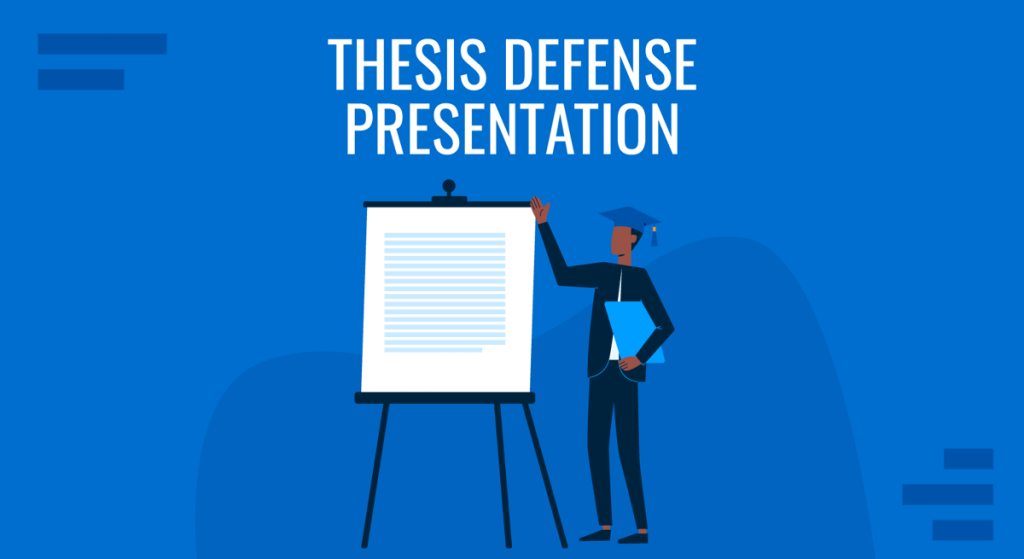
Writing a thesis is stressful, but preparing an oral defense can be even more painful. But it doesn’t have to be; with proper preparation and a good presentation, you will be able to better equip yourself comes time to present your thesis defense.
But what makes a good thesis defense?
A proper presentation helps you with your thesis defense because it helps you capture the panels’ attention and gives you cues and reminders on what to say as well.
It also helps keep your data organized while visually looking good and provides a flow structure for the rest of your presentation.
In today’s article, we will be giving you The Right PowerPoint Templates for Your Thesis Defense and a powerful outline composed of best practices and layouts specifically designed to help you defend your thesis in both written and oral presentations.
In the next segments of this article, we’ll walk you through the most feasible process on how to ace this kind of presentation.
Let’s dive into the outline of what makes a great thesis defense.
Thesis Defense Overview
Similarities.
- Type of Degree
Thesis and Dissertation Distinction Varies on Location
Three most common thesis defense myths, how to use chatgpt to structure your thesis.
- Introduction
- Literature Review
- Methodology
- Acknowledgements
- Questions and Answers
- Contact Information
- Tips During Your Oral Defense
- More Quick Tips on How to Present
A thesis defense is composed of two parts – a thesis and a defense.
The thesis, according to Grad School Hub , represents a student’s collective understanding of his or her program and major.
Universities often include a thesis in every course as one of the final requirements to earn a particular graduate or postgraduate degree.
The thesis, however, isn’t just a mere requirement.
It helps the students to grow out of their shell from their respective discipline and give them the opportunity to present all the findings of their study.
Moreover, some people think a thesis is just a long essay, but it’s not. Unlike an essay, a thesis needs to assert something.
This can be considered one of the most crucial research documents that a student makes during their academic schooling .
On the other hand, defense is the presentation of the pieces of evidence to support and prove your research.
It’s the most essential part of the thesis process.
Your presentation has to be prepared to answer questions from members of the committee and any other panel present, and it’s your job to convince them and defend your thesis with ample proof.
Prior to presenting, you have to carefully determine what appropriate evidence should be presented before the panel, depending on what thesis you have to defend.

Thesis and Dissertation Distinguished
A thesis or dissertation is usually required to complete a particular graduate degree. These two words are often used interchangeably by most students when referring to research studies.
But while being almost similar in format or structure, it’s worth noting that they have significant differences that set them apart from each other.
The very reason why thesis and dissertation are treated the same is that these two are both extensive papers. Not just merely long essays like what others are claiming.
Both of these papers are extensive. This is why students are given ample time, usually the entire last semester of the last year of study, to complete all the requirements and finally acquire their degree.
With regards to structure, both papers are very similar with few differences.
Differences Between Thesis and Dissertation
One of the significant differences between the two is to whom the paper is assigned. A thesis is usually required for those students earning a bachelor’s or master’s degree. While a dissertation is for those, who want to obtain a doctorate degree.
However, not all students taking a master’s degree are required to make a thesis. Prior to their enrollment, they have been given a choice of whether they’ll go for a non-thesis program or with a thesis.
Those who have a plan to escalate their degree to a doctorate eventually should take the path of a thesis. This is to prepare themselves for a more extensive dissertation requirement as doctorate students. Otherwise, they will be only limited to earning a master’s degree.

But above all, the most significant difference between the two papers is the purpose for which it is written.
A thesis, like what has been mentioned above, is being done by students obtaining a bachelor’s or master’s degree and has the purpose of testing their understanding of the discipline they’re engaged with.
A thesis is focused on obtaining technical expertise.
On the other hand, a dissertation is made for students to come up with an original study that other researchers haven’t already studied.
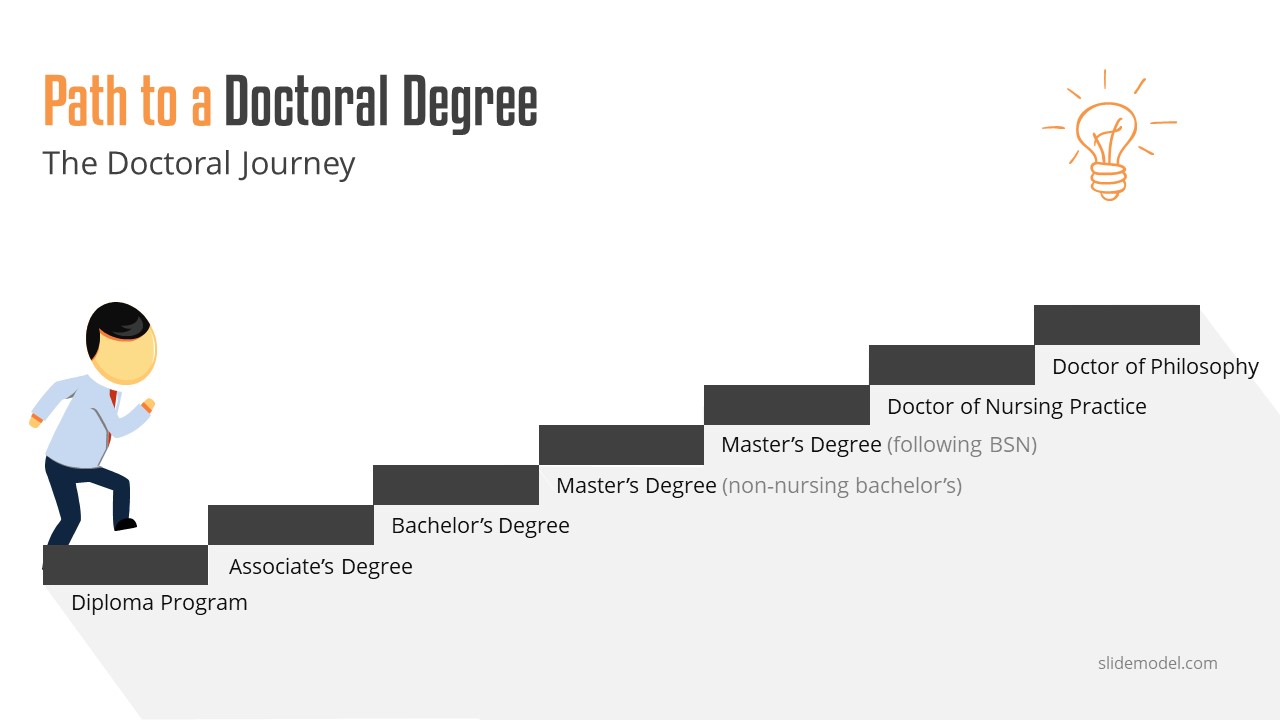
USA: In the United States of America, they consider a thesis shorter than a dissertation. In fact, aside from being a requirement to graduate in college, a thesis is now also inculcated in master’s degree programs. And since the dissertation is more extensive, the thesis is treated as preliminary in gaining a doctorate degree.
Europe: The distinction between the two papers is almost opposite to that of the USA. In Europe, a dissertation is only a broader research study from a post-graduate program and not the making of original research. Instead, educational systems in the said continent treat the doctoral thesis as a more elaborate paper writing.
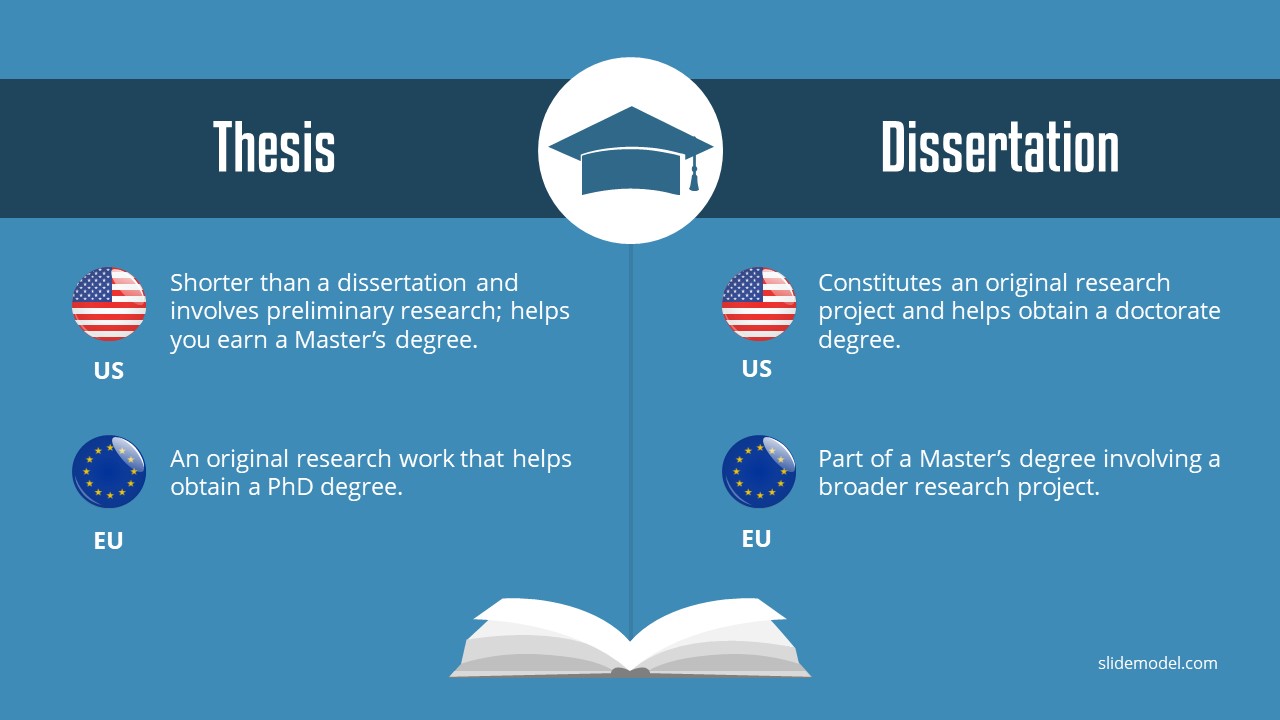
The difference between a thesis and a dissertation might not seem that big, but it’s important that we know what makes them different.
If your upcoming defense gives you pressure and uneasiness, it could be cause you are not sure what to expect. Today we will dispel three common thesis defense myths that will help you be more confident in your presentation.
“Answer all the questions correctly. Otherwise, your thesis won’t get approved.”
You are expected to have a focus on your research.
That being said, you have to study each part of your thesis, every detail, and even your sources.
You have to study and practice how to effectively deliver your presentation.
But don’t overthink to the extent that you’re stressing yourself to know everything perfectly.
Don’t overstress if you can’t answer one of the questions, this doesn’t necessarily mean the committee won’t approve your thesis.
You should know that research is a continuous study.
So you should expect that your committee will always be able to find a gap in your study to fill in future related research .
So in times you don’t exactly know the answer, admit it, and you’ll learn as they give their sides or suggestions.
Making up an answer will only displease your committee, so it’s to be upfront, honest, and transparent.
“The committee is just there to find holes in your study. They don’t care about you.”
One of the typical descriptions students have of the committee is that they are just there to poke holes in your thesis.
Going in with this perspective makes standing before them a nerve-wracking experience.
They’re not your enemy.
In fact, they are there to help you polish your study.
They might challenge you with difficult suggestions and tricky questions.
In the end, they will walk you through the process to come up with better results that won’t only benefit you but also your research.
They care about you and your study, and they’re ultimately there to make your thesis and the research better. Separate yourself from your work look at it objectively, and don’t take their comments personally .
“If your thesis defense isn’t successful, you have to start your thesis all over again”
An unsuccessful defense is one of the worst-case fears most students have.
One thing that you should be aware of is when you aren’t able to please your committee, you don’t need to start a new thesis again or go back to square one with your existing paper.
It’s unusual that your committee will ask you to change your topic and start from scratch again.
The fact that you’ve been permitted to defend your study means your research is almost complete.
They might suggest further details or ask you for minor revisions, and that’s normal.
But overall, you need to go into this defense thinking that your presentation will be successful. Otherwise, you are already setting yourself up for failure with the wrong mindset.
Remember that positive thoughts attract positive results.
Thesis Defense Presentation Structure and Slides Content
We can use language learning models like ChatGPT to help us curate the structure of our thesis presentation. Let’s see a step-by-step solution on how to apply this.
Step 1: Define the thesis topic and research questions
You can set the environment for ChatGPT to work by explaining what your thesis is going to cover and which specific questions you aim to address through the course of that document. This gives ChatGPT the context from which it shall formulate the structure. A prompt can be written like this:
“Take the role of an academic professional who shall help me to write my thesis. This thesis is going to cover the topic of (insert topic), and through its course, I want to answer these questions: Question 1 – Question 2 – Question 3 – Consider this information as the starting point for this chat.”
Step 2: Ask for an outline
With the previously provided information, ask ChatGPT to generate an outline for your presentation. If some of the points listed in the output don’t convince you, then chat with the interface until you reach a final outline. Then, ask to elaborate on each specific point for information or cues you may have overlooked.
Step 3: Ask ChatGPT which content should you place per slide
Instead of debating how are you going to trim your thesis into a presentation format, ask ChatGPT to do the decision process for you. You can be as specific as asking how many words per slide, how many slides should the presentation have, if you need any visual element, etc.
N.B.: We don’t recommend using ChatGPT to retrieve academic references as, in some cases, it can provide faulty results. You can ask if any facts on this presentation need to be checked or similar questions. ChatGPT is a powerful tool, but it shouldn’t be considered a bible, so be extra cautious about grabbing content directly from its outputs.
1. Title Page
This slide should contain the information that is provided on the title page of your hard copy . Here is an example of title page or cover slide for your title defense or thesis presentation.

- The title of your research paper
- Where you are studying
- Name and details of your course
- Name of Adviser
2. Introduction Slide
Your introduction slide should provide the committee with an idea of the following:
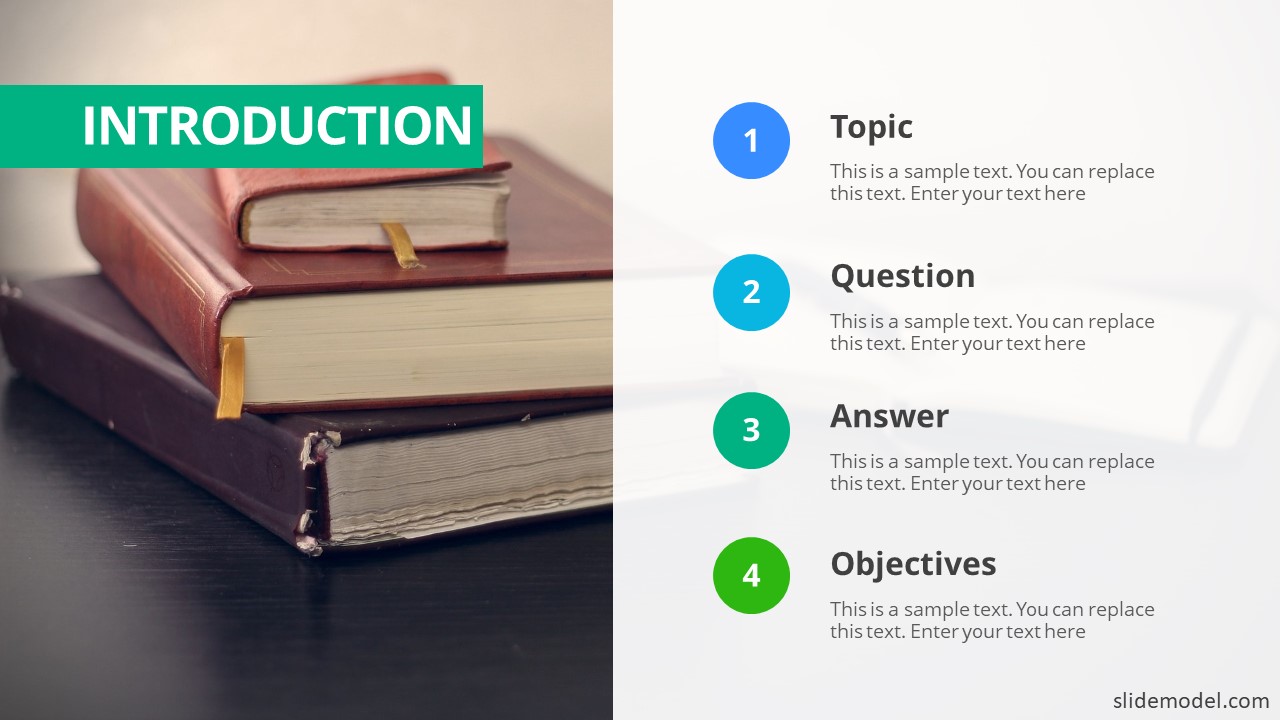
- What is the topic area that you are investigating ?
- What are the specific research questions that you set out to answer?
- Why is this question important to answer?
- What were the objectives of your research?
3. Literature Review Slide
It’s not necessary to cover everything that’s currently understood in the available literature. You may want to present the following content under a Literature Review slide:
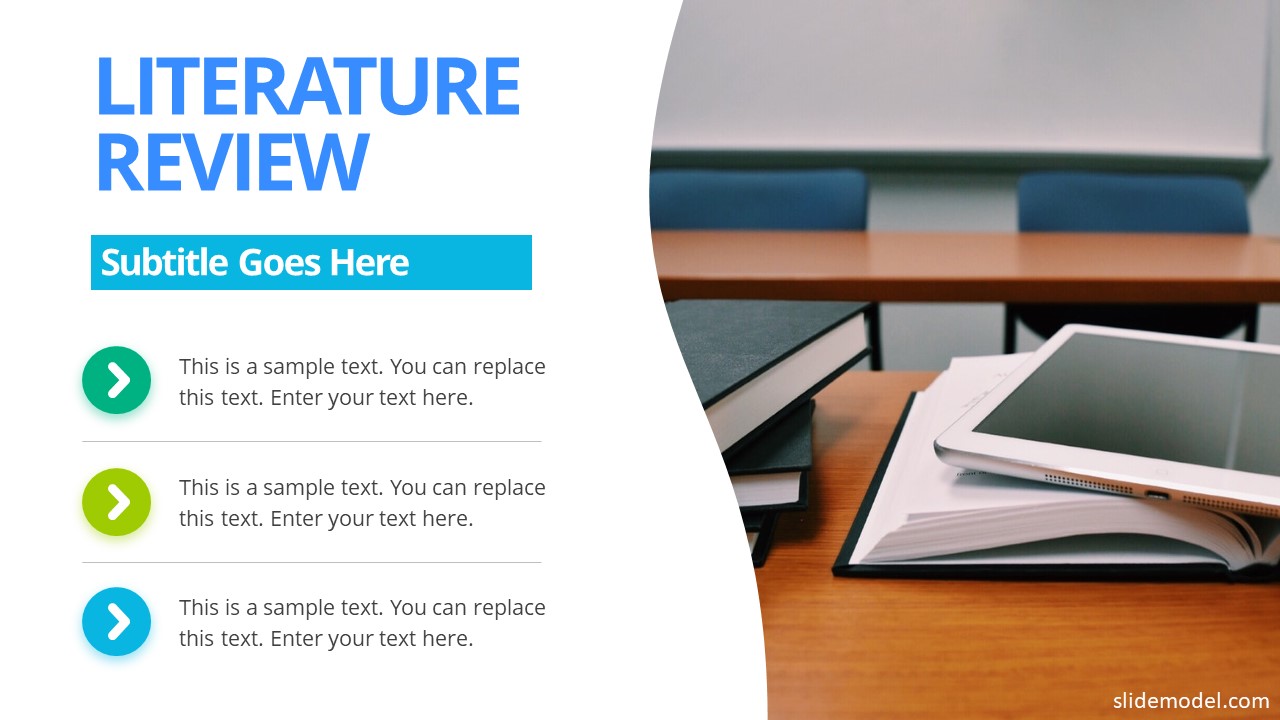
- Relevant current research that is close to your topic
- Different theories that may apply to your specific area of research
- Areas of weakness that are currently highlighted
4. Methodology Slide
Make sure to touch the factors below within your process, and include the following in the Methodology slide:

- The type of study you have conducted: qualitative, quantitative, or mixed
- The methods that you chose and why
- Details of the population, sampling methods, and other information
- Provide information regarding how you have analyzed the data that you have collected
5. Results Slide
This part should give the committee/audience a good understanding of what you’ve discovered during your research. The statistics & results slide could include the final results of your analysis, here is an example:

- An overall description of the data that you collected during your research
- The results of the analysis that you have done on that data
- What were the most significant findings from your data
6. Discussion Slide
Highlight here the meaning of the findings in relation to your discipline program and the research that you have done:
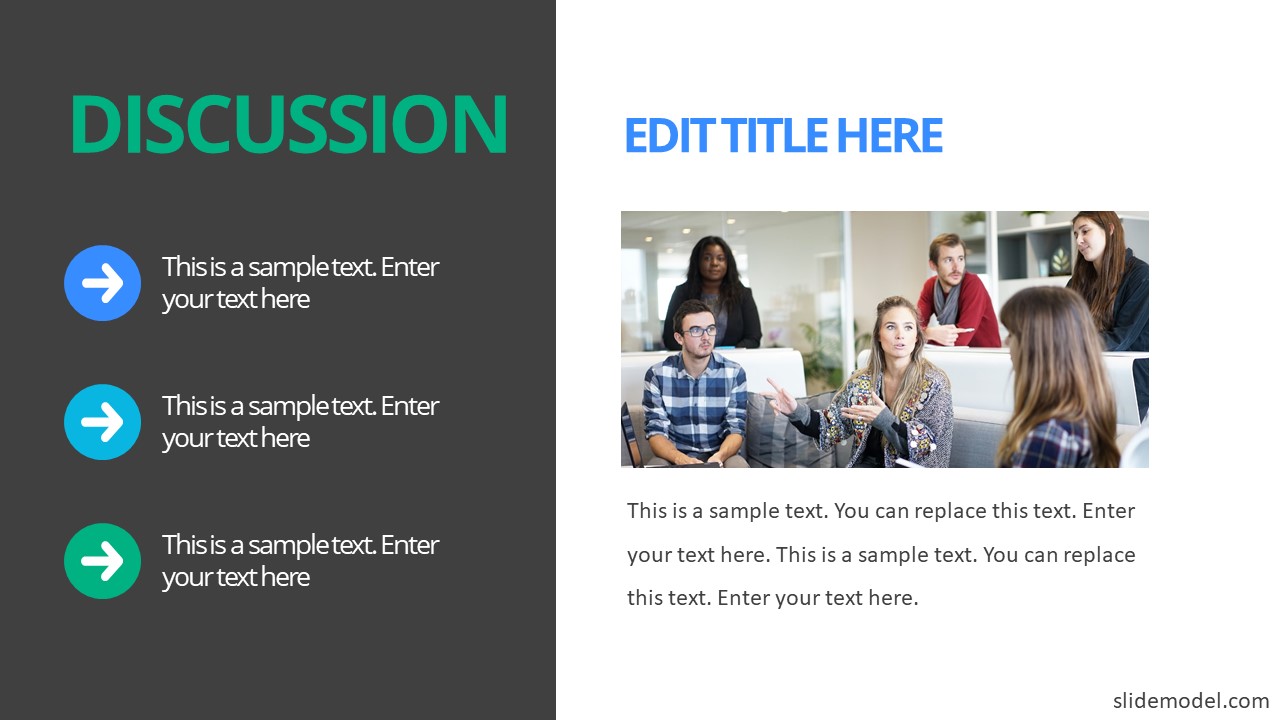
- What are the major findings, and what do they mean with regard to your research
- How do these findings relate to what others have found in the past
- How can you explain any unusual or surprising result
7. Conclusions Slide
You have to end your presentation with a conclusion summarizing all that you have found within your research. Here is an example of a Conclusion slide in a Thesis presentation:

- Restate your research questions
- Show how your results answer these questions
- Show what contribution you have made
- State any limitations to the work you have done
- Suggest future research
- Make any recommendations
See Also: How to Create a Great Investors Pitch Deck and Close the Deal
8. Acknowledgements Slide
Express gratitude to your advisor, committee members, peers, and others who supported your research journey. This slide provides a moment to acknowledge the collaborative nature of academic work.
9. Questions and Answers Slide
Dedicate a slide for audience questions at the end of your presentation.
Encourage engagement by inviting questions from the audience.
Be prepared to provide clear and concise responses to inquiries.
10. References Slide
Include a slide listing your cited sources throughout your presentation.
Use a consistent citation style (APA, MLA, Chicago, etc.).
The References slide demonstrates your thorough engagement with existing literature.
11. Contact Information Slide
If you’re open to further inquiries or collaborations, consider adding your contact information.
Include your email address or relevant professional social media handles.
How to use SlideModel AI Presentation Maker for your Thesis Presentation
If you want to save hours of manual time, you can leverage AI tools to make your thesis presentation. The best part of integrating AI tools into our workflow is that we can pair them to get even better results than we expected. With SlideModel’s AI presentation maker , users can create an entire slide deck by introducing these variables:
- Topic of your thesis
- Number of slides to include in your thesis presentation
- Outline checkup
And that’s it! Download the AI-generated presentation in PPTX format or for Google Slides, and edit it if you require adding some extra content. The core elements are already done, and you can save countless hours of hard work.
Tips During Your Oral Defense!
Review your materials.
Even if you already feel confident with your upcoming presentation, you still need to review your materials.
You can bring the hard copy of your thesis with you during the defense, but you don’t want to get lost in your presentation when you forget some specific details and have to scan your papers.
You should know your paper in and out.
Rehearse Your Presentation
It’s not wrong if it sounds like a script when you speak in your oral defense. It’s expected and understandable.
You need to practice your presentation, especially when there’s a time restriction given to every presenter.
You only need to prepare enough slides that would fit your time limit. A hundred slides aren’t suitable for a 15 to 20-minute presentation, nor 10 slides for an hour of defense.
Your rehearsal will be more effective if you practice it in front of an audience.
Note: You will experience complete silence in the defense room. You might feel awkward because, most of the time, you’re the only one speaking out loud. This is completely fine, and it’s something you should practice in rehearsal should you be afraid.
Narrow the Presentation of Ideas
Regarding your slides, you don’t have to include everything that’s in your paper. You should narrow down your ideas to the main points and the most important details, such as the statistics and findings.
If the members of your committee think you lack details or they want to hear a further explanation, they won’t hesitate to ask you.
Prepare for the Unexpected Questions
The panel tends to challenge the presenters, usually through some hard questions.
Its aim is how well do you you have done your research and how prepared you are.
But as long as you know the ins and outs of your paper, you shouldn’t lose your confidence regardless of which questions they ask.
Just keep in mind that what you’re saying in your oral defense is not in conflict with what is written on the hard copy you provided them.
What To Do When You Don’t Know the Answer
If the committee asks you a question and you don’t know the answer, don’t make up a baseless answer.
Baseless means out-of-context answers or something without proof or backup.
How To Deal With The Nervousness
The committee expects you to be nervous. Of course, it’s normal.
However, one effect of being nervous is the changes in your behavior.
There’s a tendency for you’ll talk fast, which will make it hard for the committee to understand you.
It might also cause you to have a mental block.
So try to slow down. Take a deep breath.
Inhale, exhale. Remember to breathe!
It’s OK to pause, and it’s OK to take your time; it’s more important that the committee clearly understands what you are trying to articulate.
More Quick Tips on How to Present!
- Introduce yourself at the beginning
- Introduce the title of the presentation
- Don’t read your notes if possible
- Don’t speak too fast
- Put an emphasis on what you’re saying so you don’t sound monotonous
- Look at your adviser once in a while for possible signs
- Stand on the right of the white screen if you are right-handed so you can easily refer to the slide without giving your back to the committee
- Face the audience when you talk
- Keep an eye contact
- Make sure to keep attention to the reactions of the committee and don’t forget to react in turn
We hope you enjoyed this article on how to do a proper thesis defense and how to best prepare for one using proven tips and techniques to help you get through this. Hopefully, after your defense, you will be set as the one in your class to deliver an inspiring graduation speech for your peers. If you have value, please remember to share this article. We also recommend you read these Thesis Statement Examples for inspiration to create your own professionally.
1. MasterDoc PowerPoint Template

Creating a Thesis presentation should be a straight forward task; based on your thesis document and following the tips described above you have a high level structure already outlined. The MasterDoc PowerPoint template provides professional layouts with texts and image placeholders; so you can create document like slides using your thesis defense as your content. This template is ideal for a highly detailed documents, where visuals and words unite to illustrate one concept per page. The result is an asset that can be read and digested more quickly than either your thesis document or a presentation created for assisting a speech. A document created with the MasterDoc PowerPoint templates is meant to be printed or distributed, read on screen without the accompaniment of a presenter or used in an e-learning platform as pure learning content.
Use This Template
2. Thesis Presentation PowerPoint Template
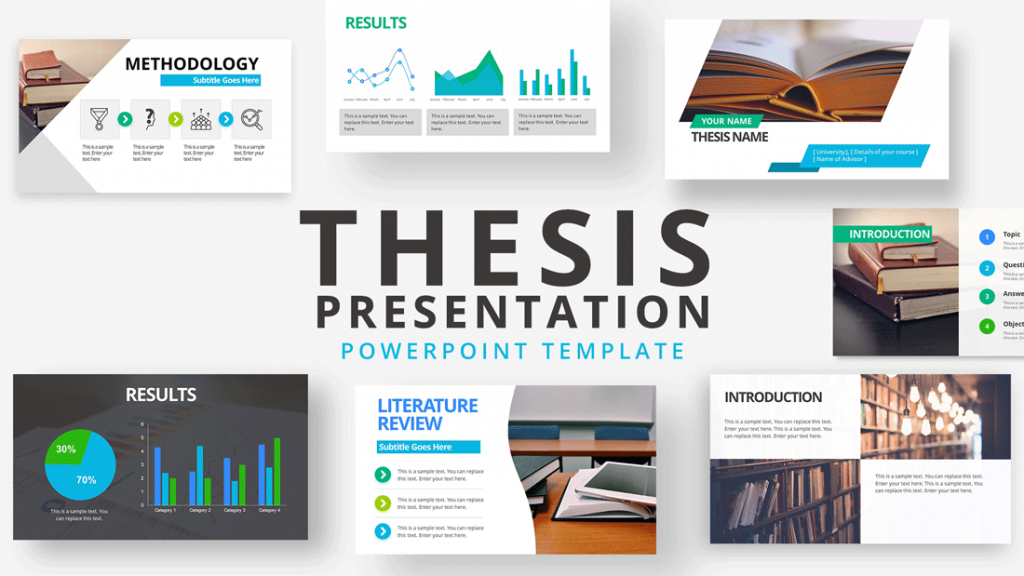
You had invested a considerable time researching, testing hypothesis and confirming your thesis. Craft your thesis presentation with the same level of detail you applied in your work. Using the Thesis Presentation PowerPoint Template you will focus only in your content and your message. The layouts, images,design and structure will be taken care by the template.
3. Master Thesis PowerPoint Template

The Master Thesis PowerPoint Template is a professional document designed for postgraduate degrees presentations. It provides simple sections that follow the structure and best practices of traditional research thesis presentations. Starting with the introduction to the theory and state of the art scenario; following with hypothesis research and its findings and concluding with the confirmation or negation of the initial thesis statement.
4. Essay Outline PowerPoint Template

Your thesis defense can be accompanied by an essay, that states your thesis and argues about it using several supporting paragraphs. This kind of document is ideal to be an intermediate step between reading assisting to the thesis presentation and reading the complete thesis documentation. It has more information that your thesis defense abstract, but does summarizes the supporting evidence and examples that allows the argument of each idea behind the thesis. You can use the Essay Outline Template to present your Essay outline and create an essay linked to your thesis defense documentation.
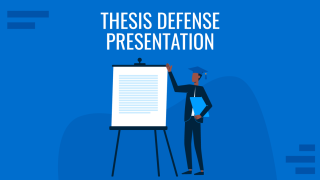
Like this article? Please share
Academics, Degree, Dissertation, Doctorate, Education, Faculty, Master, PhD, Student, Thesis Filed under Presentation Ideas
Related Articles

Filed under PowerPoint Tutorials • May 22nd, 2024
How to Cite a PowerPoint in APA
Learn how to correctly apply the APA style in your presentations by learning how to cite slides, books and images in APA in PowerPoint.

Filed under Presentation Ideas • November 9th, 2023
How to Create and Deliver a Research Presentation
Presentation is one of the final steps of a research endeavor. Learn how to make and deliver a research presentation using our templates and tips.

Filed under Education • September 10th, 2023
How To Write An Essay? – Where to start?
Do you wonder How to write an essay ? Start with the essay structure. This post describes the standard essay structure with its content, and which essay types are popular. Develop your writing skills using the best practices of Essay Structure.
36 Responses to “How To Do a Proper Thesis Defense Using the Right PowerPoint Presentation”
Great job! This has made my thesis presentation a whole lot easier.
Excellent !!!!!
Now I feel I’m quite confident on how to do my dissertation presentation properly and how to defend it. I will share that with other friends and colleagues.
Thank you so much for your kind help.
Best regards, Awad
Thank you for such a valuable guide.
it was very helpful
Thanks a bunch for the general summary for thesis defense with all related information that we might have to know. Great job!
Great tips.
i have proposal defense in two days and im so nervous right now! reading this is helpful in some ways thankyou!
It’s very helpful and understandable. Easy steps to follow.
I found it very helpful to refresh and make my self ready for my defense!
Thank you a lot this article. It’s really helpful!
Naveen Kumar S: Thank you its very Helpful. I appreciate all your effort this is very useful.
Very important and interesting so go on thank you
I really like it. In the near future I am going to present for the MA thesis. Therefore, it will guide me a lot. If you can please attach with this email the detail.
I do like the article as it proves to be valuable and worthy. I enjoyed reading every single note. It helped me feel at ease and have confidence when my viva day takes place. THANK YOU SO MUCH.
Appreciate your Assistance
Thanks a lot for the gist
Thank you so much, I got full information and knowledge.
This has made me look forward to my thesis defense. Thanks a lot
Very useful
thank you very much for your best information
Thank you very much the article is full of knowledge on Thesis as well as dissertation defense. Big Up!
I am appreciative. Well informative and educative.
Thanks immensely for these wonderful tips on presentation during defense. I personally found more useful to me as I prepare to defend my Master Dissertation.
Thank you very much! I now feel more confident.
Thanks for your good self overall usability of the Participations motivated points and contribute significantly in thesis defense practices. Best wishes to one and All
Happy To Help.
Thank you very much. As I am pursuing for my PhD in Leadership, I got it so meaningful and worth having.
Your tips on What a Thesis and Dissertation are, are on point. I have fully understood their differences and similarities. I have also noted the killer way of summaring a Power Point Presentation. Slidemodel.com…you are just a force to reckon with. I need more information…in case you have models you can share with me and those interested in this subject covered.
Thanks a million times for your timely guidance. Just preparing to do my PhD Thesis defense.
this was very, very helpful…Thank you!
Highly appreciate your effort to deliver what a student is looking for. I find your article really helpful and to the point. Thanks !
Regarding to my P.P, I’ve understood so many issues from this. Thankyou!
i got it as it is so important for my deffence presentation, thanky you very much
This Material was very hopeful and encourage any student who prepare any presentation relation with thesis. It also combined more encauragable and it enhance presentation!
Thought provoking content Thank you.
Great comments. very helpful
Leave a Reply
Want to Get your Dissertation Accepted?
Discover how we've helped doctoral students complete their dissertations and advance their academic careers!
Join 200+ Graduated Students

Get Your Dissertation Accepted On Your Next Submission
Get customized coaching for:.
- Crafting your proposal,
- Collecting and analyzing your data, or
- Preparing your defense.
Trapped in dissertation revisions?

- Code of Ethics
- Dissertation Editing
- Dissertation Coaching
- Free Consultation
How to Create a Dissertation Presentation
While writing your dissertation is a Herculean task, the work isn’t quite over once the dissertation is finished. In many disciplines, a dissertation presentation is required as part of the dissertation defense . This thorough, comprehensive presentation is your opportunity to demonstrate the depth and validity of your research in a clear and compelling way.
Before you begin working on your dissertation presentation, you’ll want to do some homework about the expectations for your presentation. Consult your dissertation advisor and ask for your department or university’s guidelines for the dissertation presentation. It may also be helpful to review dissertation presentations made by recent graduates of your doctoral program.
These are some commonly asked questions about the dissertation presentation:
- What is a dissertation presentation?
- How does it differ from a dissertation defense?
- How do I structure my dissertation presentation?
- What are some additional considerations for the dissertation presentation?
What Is a Dissertation Presentation?

A dissertation presentation is usually a 10-15 minute overview of your dissertation research that focuses on the study and findings recorded in chapters four and five of your dissertation. The dissertation presentation consists of 9-12 slides made using PowerPoint or another type of presentation software.
There are conventions to adhere to when creating the dissertation presentation, and each slide serves a specific purpose. The presentation slides offer in-depth insight into the data gathered during the study, as well as any conclusions you may have reached. These slides give you an opportunity to explore the data and discuss the significance of your study and its findings.
Dissertation Presentation vs. Dissertation Defense
While the culminating moment of a doctoral degree has long been the dissertation defense, many disciplines and programs now prefer for candidates to complete a dissertation presentation. Done in lieu of or in addition to a traditional defense, a dissertation presentation is made distinctive by its inclusion of visual elements such as charts, graphs, or images.
Dissertation presentations are also a pragmatic approach during the era of online programs and Zoom. While a dissertation defense is powered by an oral defense and discussion with the dissertation committee, a dissertation presentation offers a strategic way to plan and structure the conversation. A dissertation presentation also affords you the opportunity to show the narrative arc of your progression from asking the question, searching the literature, creating the study, and evaluating your findings.

Dissertation Presentation Structure
Storytelling is a great way to think about how you will approach your dissertation presentation. Show the linear development of your topic and offer a clear and concise snapshot of the work you’ve done. Bear in mind that brevity is important; slide space is limited, so you’ll want to keep it short and sweet.
The structure of your dissertation presentation will roughly follow your table of contents, which will serve as a map for crafting your slides. The first half of your dissertation presentation slides will mirror your dissertation proposal, or the first three chapters of your dissertation. Slides within your dissertation presentation should include:
- Problem Statement Write a sentence or two outlining the problem and why it caught your attention.
- Literature Review Offer observations about the general consensus of existing research on or related to your topic, as well as gaps in the literature–particularly those bridged by your research study.
- Purpose of the Study This statement should reflect the purpose statement in your dissertation .
- Research Questions Include your primary question as well as secondary questions that resulted from gaps in the literature.
- Sample and Population/Instrumentation This would be a good place to include graphics or other visual elements.

The second half of the slides in your dissertation presentation will be grounded specifically in the fourth and fifth chapters of your dissertation. These slides will include information about your data collection, analysis, and findings. You can also include an image or two relevant to your research (especially if you have pictures from the field or lab) and personal experience.
- Data Collection and Analysis Include charts or graphs that illustrate your research on this slide.
- Research Findings It may be difficult to abridge dozens of pages of results, but try to summarize your findings in a sentence or two. A table may be the best way to present your results.
- Implications Now we’re getting to the good stuff! You’ve offered a thorough overview of the research you did; take the opportunity to highlight why it matters. What dark corner of your discipline is now illuminated because of the work you’ve done?
- Recommendations As a now-bona fide scholar in the field, this is a place for you to offer recommendations for further research. Identify two or three more research questions that you encountered during the course of your research. What is the next chapter of this story?
- Abstract Compose a 100-150 word abstract for your dissertation . Follow the format of a journal article. This will come in handy for submissions to conferences and journals (the next step on your academic journey!).
- Acknowledgements A quick ‘thank you’ never hurts–feel free to copy your acknowledgements from your dissertation. Don’t forget to thank your committee.
- Questions Use the final slide of your dissertation presentation to open the floor for questions from your dissertation committee.

Additional Considerations
Though it is first and foremost a professional document, the dissertation presentation also offers you an opportunity to showcase your style as a scholar. Design your slides for optimum communication and visual appeal. Use graphics and images that reinforce the overarching message of your dissertation. These visual cues will serve as compelling support for your overall narrative, and each one should enhance your dissertation committee’s understanding of your topic, findings, and analysis.
In addition to graphics and images, think carefully about the aesthetic of your dissertation presentation. Prize high-impact verbiage that gets to the heart of your topic without crowding your slides. Give yourself enough time to draft and revise each slide; it’s not a bad idea to get a second set of eyes on your dissertation presentation, as well as constructive feedback. Remember, this is your final chance to make a lasting impression on your dissertation committee –give them a presentation they won’t soon forget.
Related posts:

Courtney Watson, Ph.D.
Courtney Watson, Ph.D. is an Associate Professor of English at Radford University Carilion, in Roanoke, Virginia. Her areas of expertise include undergraduate and graduate curriculum development for writing courses in the health sciences and American literature with a focus on literary travel, tourism, and heritage economies. Her writing and academic scholarship has been widely published in places that include Studies in American Culture , Dialogue , and The Virginia Quarterly Review . Her research on the integration of humanities into STEM education will be published by Routledge in an upcoming collection. Dr. Watson has also been nominated by the State Council for Higher Education of Virginia’s Outstanding Faculty Rising Star Award, and she is a past winner of the National Society of Arts & Letters Regional Short Story Prize, as well as institutional awards for scholarly research and excellence in teaching. Throughout her career in higher education, Dr. Watson has served in faculty governance and administration as a frequent committee chair and program chair. As a higher education consultant, she has served as a subject matter expert, an evaluator, and a contributor to white papers exploring program development, enrollment research, and educational mergers and acquisitions.
Comments are closed.
Like what you're reading?
How to create a great thesis defense presentation: everything you need to know
Get your team on prezi – watch this on demand video.
Anete Ezera April 13, 2024
Ready to take on your thesis defense presentation? It’s not just about wrapping up years of study; it’s your moment to share your insights and the impact of your work. A standout presentation can make all the difference. It’s your chance to highlight the essentials and really connect with your audience.
This is where Prezi comes into play. Forget about flipping through slide after slide. With Prezi, you craft a narrative that pulls your audience in. It simplifies the complex, ensuring your key points hit home. Let’s explore how Prezi can help transform your thesis defense into a successful presentation.

What is a thesis defense presentation and why are they needed?
Whether you’re preparing for a master’s thesis defense or a Ph.D. thesis defense, this final step in your academic journey is the one with the most significance, as it dramatically influences your final grade. It’s also your chance to display the dedication and effort you’ve put into your research, a way to demonstrate how significant your work is.
So, why is this such a big deal? A good presentation helps convince your teachers that your research is solid and makes a difference in your field. It’s your time to answer questions, show that your research methods were sound, and point out what’s new and interesting about your work. In the end, a great thesis defense presentation helps you finish strong and makes sure you leave a lasting impression as you wrap up this chapter of your academic life.
Best practices for making a successful thesis defense presentation
In order to craft a standout thesis defense presentation, you need to do more than just deliver research findings. Here are some key strategies to ensure success, and how Prezi can play a crucial role in elevating your presentation.
Start with a strong introduction
Kick-off with an engaging introduction that lays out your research question, its significance, and your objectives. This initial segment grabs attention and sets the tone. Using Prezi’s zoom feature can make your introduction pop by visually underscoring key points, helping your audience grasp the importance of your work right from the start.
Organize your presentation clearly
A coherent structure is essential for guiding your audience through your thesis defense presentation. Prezi can help by offering a map view of your content’s layout upfront, providing a clear path through your introduction, methodology, results, and conclusion. This clarity keeps your audience engaged and makes your arguments easier to follow.
Incorporate multimedia elements
Adding multimedia elements like videos, audio clips, and animations can greatly improve the appeal of your thesis defense presentation. Prezi supports the seamless integration of these elements, allowing you to bring your research to life in a more vibrant and engaging way. Videos can serve as powerful testimonials or demonstrations, while animations can help illustrate complex processes or changes over time. This variety keeps your audience engaged and helps convey your message in a more exciting way.

Simplify complex data
Your findings need to be presented in a way that’s easy for your audience to understand. Prezi shines here, with tools that transform intricate data into clear, engaging visuals. By implementing charts and graphs into your presentation, you can make your data stand out and support your narrative effectively.
Engage your audience
Make your thesis defense a two-way conversation by interacting with your audience. Whether it’s through questions, feedback, or direct participation, engagement is key. Prezi allows for a flexible presentation style, letting you navigate sections in response to audience input, creating a dynamic and engaging experience.
Highlight key takeaways
Emphasize the key takeaways of your research throughout your presentation to ensure your audience grasps the most critical aspects of your work. With Prezi, you can use spotlighting and strategic zooming to draw attention to these takeaways, making them stand out. This method helps reinforce your main points, ensuring they stick with your audience long after your presentation concludes. By clearly defining what your audience should remember, you guide their understanding and appreciation of your research’s value and implications.
Practice makes perfect
Confidence in delivery comes from thorough practice. Familiarize yourself with every aspect of your thesis defense presentation, including timing, voice control, and gestures. Prezi Video is a great tool for rehearsing, as it allows you to blend your presentation materials with your on-camera performance, mirroring the live defense setting and helping you polish your delivery.

End with a lasting impression
Conclude your presentation powerfully by summarizing your main findings, their implications, and future research directions. Prezi’s ability to zoom out and show the big picture at your conclusion helps reinforce how each section of your presentation contributes to your overall thesis, ensuring your research leaves a memorable impact on your audience.
By using these tips and taking advantage of what Prezi offers, you can make your thesis defense presentation really stand out. It’ll not only hit the mark with your audience but also clearly show why your research matters.
Meeting tight deadlines with Prezi
Facing a looming deadline for your thesis defense presentation? Prezi offers smart solutions to help you create a polished and engaging presentation quickly, even if it feels like you’re down to the wire.
A closer look at Prezi AI features
Prezi AI is a standout feature for those pressed for time. It assists in structuring your presentation efficiently, suggesting design elements and layouts that elevate your content. This AI-driven approach means you can develop a presentation that looks meticulously planned and executed in a fraction of the time it would normally take. The result? A presentation that communicates the depth and value of your research clearly and effectively, without the last-minute rush being evident. Here’s what Prezi AI can do:
- Streamlined creation process: At the core of Prezi’s efficiency is the AI presentation creator . Perfect for those last-minute crunch times, it’s designed to tackle tight deadlines with ease.
- Easy start: Kick off your presentation creation with just a click on the “Create with AI” button. Prezi AI guides you through a smooth process, transforming your initial ideas or keywords into a structured and visually appealing narrative.
- Visual impact: There’s no need to dive deep into design details. Simply provide some basic input, and Prezi AI will craft it into a presentation that grabs and holds your audience’s attention, making your thesis defense visually compelling.
- AI text editing: Spending too much time fine-tuning your message? Prezi AI text editing features can help. Whether you need to expand on a concept, clarify complex terms, or condense your content without losing impact, Prezi AI streamlines these tasks.
- Content refinement: Adjust text length for deeper explanation, simplify language for better understanding, and ensure your presentation’s content is precise and to the point. Prezi AI editing tools help you refine your message quickly, so you can focus on the essence of your research.
Using Prezi Video for remote thesis defense presentations
For remote thesis defenses, Prezi Video steps up to ensure your presentation stands out. It integrates your on-screen presence alongside your presentation content, creating a more personal and engaging experience for your audience. This is crucial in maintaining attention and interest, particularly in a virtual format where keeping your audience engaged presents additional challenges. Prezi Video makes it seem as though you’re presenting live alongside your slides, helping to simulate the in-person defense experience and keep your audience focused on what you’re saying.

Using these advanced Prezi features, you can overcome tight deadlines with confidence, ensuring your thesis defense presentation is both impactful and memorable, no matter the time constraints.
The Prezi experience: what users have to say
Prezi users have shared compelling insights on how the platform’s unique features have revolutionized their presentations. Here’s how their experiences can inspire your thesis defense presentation:
Storytelling with Prezi
Javier Schwersensky highlights the narrative power of Prezi: “This is a tool that is going to put you ahead of other people and make you look professional and make your ideas stand out,” he remarks. For your thesis defense, this means Prezi can help you craft a narrative that not only presents your research but tells a story that captures and retains the committee’s interest.
Flexibility and creativity
Tamara Montag-Smit appreciates Prezi for its “functionality of the presentation that allows you to present in a nonlinear manner.” This flexibility is key in a thesis defense, allowing you to adapt your presentation flow in real time based on your audience’s engagement or questions, ensuring a more dynamic and interactive defense.
The open canvas
Vitek Dočekal values Prezi’s open canvas , which offers “creative freedom” and the ability to “create a mind map and determine how to best present my ideas.” For your thesis defense, this means Prezi lets you lay out and show off your work in a way that makes sense and grabs your audience’s attention, turning complicated details into something easy and interesting to follow.
Engagement and retention
Adam Rose points out the engagement benefits of Prezi: “Being able to integrate videos is extremely effective in capturing their attention.” When you need to defend a thesis, using Prezi to include videos or interactive content can help keep your committee engaged, making your presentation much more memorable.
These real insights show just how effective Prezi is for crafting truly influential presentations. By incorporating Prezi into your thesis defense presentation, you can create a defense that not only shows how strong your research is but also leaves a lasting impression on your audience.
Thesis defense presentations for inspiration
Prezi is much more than a platform for making presentations; it’s a place where you can find inspiration by browsing presentations that other Prezi users have made. Not only that, but Prezi offers numerous templates that would be useful for thesis defense presentations, making the design process much easier. Here are a few examples that you may find helpful:
Research project template by Prezi
This Prezi research project template stands out as an ideal choice for thesis defense presentations due to its well-structured format that facilitates storytelling from start to finish. It begins with a clear introduction and problem statement, setting a solid foundation for the narrative. The inclusion of sections for user research, interviews, demographics, and statistics allows for a detailed presentation of the research process and findings, which are crucial when defending a thesis.
Visual elements like user mapping and journey maps help make complex information understandable and engaging, which is crucial for maintaining the committee’s attention. Additionally, addressing pain points and presenting prototypes showcases problem-solving efforts and practical applications of the research. The template culminates in a conclusion that ties everything together, emphasizing the research’s impact and future possibilities. Its comprehensive yet concise structure makes it an excellent tool for communicating the depth and significance of your work in a thesis defense.
Civil rights movement Prezi
This Prezi on the Civil Rights Movement exemplifies an effective thesis defense presentation by seamlessly blending structured content, multimedia enhancements, and dynamic navigation. It organizes information into coherent sections like “About,” “Key Events,” and “Key People,” offering a comprehensive view ideal for a thesis presentation. The strategic use of videos adds depth, providing historical context in a dynamic way that text alone cannot, enhancing the audience’s engagement and understanding.
Furthermore, Prezi’s open canvas feature brings the narrative to life, allowing for a fluid journey through the Civil Rights Movement. This method of presentation, with its zooming and panning across a virtual canvas, not only captivates but also helps to clarify the connections between various elements of the research, showcasing how to effectively communicate complex ideas in a thesis defense.
AI-assisted history template
This AI-assisted presentation template stands out as a great choice for thesis defense presentations, especially for those rooted in historical research. By merging striking visuals with rich, informative content, you can use this template to craft a narrative that breathes life into past events, guiding the audience on an engaging journey through time. Its sequential storytelling approach, empowered by Prezi AI , ensures a smooth transition from one historical point to the next, demonstrating the depth and continuity of your research. This template showcases Prezi AI’s capability to enhance narrative flow. By integrating advanced visuals and text, it captivates audiences and makes it an invaluable tool for presenting complex historical theses in a clear, compelling way.
Master your final grade with a Prezi thesis defense presentation
Preparing for a thesis defense, whether for a master’s or Ph.D., is a pivotal moment that significantly influences your final grade. It’s your platform to demonstrate the dedication behind your research and its importance in your field. A well-executed presentation convinces your educators of your research’s validity and your ability to bring fresh perspectives to light.
To craft a successful thesis defense presentation, Prezi’s innovative features can be a game-changer. Prezi can empower you to transform presentations into captivating stories and provide you with the flexibility and creative freedom needed to make your presentation an outstanding success. Incorporating videos or utilizing Prezi’s non-linear presentation style can keep your committee engaged and emphasize your research’s significance.
Prezi also serves as a hub of inspiration, offering templates perfect for thesis defenses. From structured research project templates to dynamic historical narratives, Prezi provides tools that communicate your thesis’s depth and significance effectively, ensuring you leave a memorable impact on your audience. So, it’s time to revamp your thesis defense presentation and change it from dull to inspirational with Prezi.

Give your team the tools they need to engage
Like what you’re reading join the mailing list..
- Prezi for Teams
- Top Presentations
Unsupported browser
This site was designed for modern browsers and tested with Internet Explorer version 10 and later.
It may not look or work correctly on your browser.
- Presentations
How to Start and Give a Great Thesis Defense Presentation
To complete a graduate degree, you'll likely need to create a thesis defense presentation. You must complete a thesis to finish many graduate degree programs.

A thesis is a paper where you explore a topic in depth that's related to what you’ve studied. After completing your thesis paper, you will be asked to defend it through a presentation.
You give this thesis defense in a meeting with a panel of two or more professors in your program. The panel could include other professionals related to your field.
In your thesis defense presentation, you will be asked questions about your topic. The purpose of the questions is to get you to think deeply about your work, so the questions could be open-ended.
To create a thesis defense presentation, you need to know how to make a thesis presentation and how to start your thesis defense. Keep reading to find out more about thesis defense presentations.
How to Structure Your PPT for Thesis Defense

Thesis defense presentations can vary in length. They can be 20 minutes long or two hours long. It depends on how much time is allowed for your presentation and questions.
Talk to your professor to find out how much time is set aside for your presentation. Your thesis defense presentation will be unique to your thesis. But a good presentation includes the following structure:
- Title . You need a title just as your research paper needed a title. The title slide will include the information that you’d include on your paper title. This information can include the title, your name, your school, and course name.
- Introduction . Just like most presentations, your thesis defense presentation should include an introduction slide. This slide should have the topic of your thesis and the question that your presentation answers. It should also include any objections to your research and the answer you’ll be defending in your thesis presentation.
- Literature Review . Next, create two or more slides with a review of the literature used in your research. It doesn’t need to be a complete bibliography. Although you do need to cite your sources, these slides should include your most relevant sources.
- Methodology . These slides in your thesis presentation are where you describe what method you used and an explanation of why you chose that method. If you've got some original research, include the details of that research and how you analyzed the data that you got from that research.
- Results . Some of the most important slides of your PPT for thesis defense contain the results of your research. This should include a description of the data you collected by researching and the results of your data analysis. You also should highlight what your most noteworthy finding was.
- Discussion . These slides of your PPT for thesis defense need to include your research results. Also, show how the results support your argument and how it relates to your original question.
- Conclusion . The conclusion thesis presentation slides should restate your original research questions, show the results of your research, and suggest future research and any final recommendations.
- Ending Slide . The ending slides of your thesis defense presentation are where you add an interesting fact, quote, gif, or hypothetical question. The point is to get your audience to continue to think about your topic while also grabbing their attention. You want your presentation to be memorable.
How to Make a Thesis Presentation
After you’ve seen what the structure of a thesis defense presentation is, there are some more tips that you can follow. Here are tips on how to create a thesis defense presentation:
1. Define Your Concept

After choosing which template to use, the next step is to choose the concept of your thesis defense presentation. Your concept should be relevant to your thesis. To have a fully rounded concept, try to make your presentation templates design relevant to your thesis topic.
Before working on your defense, think about the message you want to convey. This will help you choose elements such as font images and a theme that'll be cohesive.
2. Know Your Audience
Most people give their thesis defense presentation to an academic panel. This panel will look to see if you've developed a thorough understanding of your topic and thesis. They’ll also be looking to see if you've got a solid foundation for your argument.
This is why your presentation is important. You don’t want a sloppy presentation because it can give the impression of laziness and that you don’t care about your presentation. So, choose all aspects of your presentation carefully.
3. Keep Your Slides Focused

Part of giving a good thesis presentation is to have focused slides. This means that you don’t want to have too much information on a slide. It’s best to follow the rule of one point per slide. If you've got too much on a single slide, it can be hard for the audience to follow you.
4. Structure Your Presentation
After you’ve chosen your concept, it's time to structure the content of your thesis. When structuring your information, you want to show that you understand the subject matter and that you're organized.
5. Less Is More

Each slide should have enough information that you can make your point. It’s important that your audience listens more than they read. By speaking, you show your audience that you know the topic you’re presenting on. So, when creating your slides, remember that less is more.
6. Consider Your Typography
After choosing your thesis presentation subject, consider what typography to use. Your typography should create an impact without distracting from your topic.
When considering your typography, consider your text's colors. Your text's colors should contrast with your slide's background. If the text doesn’t contrast well, it can distract the audience, causing them not to pay attention as you speak.
7. Stick to Important Data

Include data that'll strengthen your argument. Your data should also show that you’ve researched your thesis. If you can, add visuals that are relevant to your data. Visuals stimulate your brain and can increase how fast you process information. So, including relevant visuals can make your data easier to process and remember.
8. Consistency Is Key
When thinking about how to make a thesis presentation, think about consistency. For an impressive presentation, your presentation should flow well. It’s easier to have consistency when using a template because it’s already designed by a professional.
Check your finished presentation for consistency. This means making sure all your titles on slides are the same font and font size. Also, make sure that your body text is consistent throughout.
9. Explain Your Thesis

The next step in how to make a thesis presentation is to explain your thesis in great detail. The first part of this is your methodology slide . This is where you explain what method you used for your research, why you chose the topic, and how you conducted your research.
For this part of your thesis, chart and tables in your presentation are helpful in explaining data. In this section, keep your text minimal to let the chart, graphs, and data stand out.
Next, tell the audience what the data means. Infographics are a great option to use in this section. Infographics and icons can quickly and simply show your message.
10. End Your Thesis
The last section of your thesis presentation is where you end it. Make your ending memorable to keep your audience thinking.
In your conclusion, overview your thesis topic and remind the audience of the answer that your research proved. Next, cover the important research points you want your audience to remember. A slide with icons is a great way to do this. Also, address your shortcomings in your research and how there can be improvements in future research.
Finally, use some more presentation tips by reading this helpful article:

A Top Source for Presentation Templates
Envato Elements is the best place for presentation templates. Plus, they also have more than just premium templates. They've icons, photos, fonts, and more. To gain access to these digital elements, you must pay a low monthly fee and sign up to become a member. Once you sign up , you get unlimited access and downloads to digital elements.
Explore Presentation Templates

A premium template saves you time because you're starting with a great base. Just add your information when using a template. This is a lot quicker than trying to design a presentation from scratch. If you like to customize your presentation, you still can find a good premium template that's easily customizable.
Every template is designed by a professional to look stylish and impressive. This means that your presentation will stand out among all the made-from-scratch presentations.
Use a Premium Template for Your Thesis Defense Presentation Today!
Now that you’ve been given tips on how to start a thesis presentation and what it should contain, put this information to use when creating your thesis presentation. Save time from having to create a presentation from scratch by downloading a premium template today!


Princeton Correspondents on Undergraduate Research
How to Make a Successful Research Presentation
Turning a research paper into a visual presentation is difficult; there are pitfalls, and navigating the path to a brief, informative presentation takes time and practice. As a TA for GEO/WRI 201: Methods in Data Analysis & Scientific Writing this past fall, I saw how this process works from an instructor’s standpoint. I’ve presented my own research before, but helping others present theirs taught me a bit more about the process. Here are some tips I learned that may help you with your next research presentation:
More is more
In general, your presentation will always benefit from more practice, more feedback, and more revision. By practicing in front of friends, you can get comfortable with presenting your work while receiving feedback. It is hard to know how to revise your presentation if you never practice. If you are presenting to a general audience, getting feedback from someone outside of your discipline is crucial. Terms and ideas that seem intuitive to you may be completely foreign to someone else, and your well-crafted presentation could fall flat.
Less is more
Limit the scope of your presentation, the number of slides, and the text on each slide. In my experience, text works well for organizing slides, orienting the audience to key terms, and annotating important figures–not for explaining complex ideas. Having fewer slides is usually better as well. In general, about one slide per minute of presentation is an appropriate budget. Too many slides is usually a sign that your topic is too broad.

Limit the scope of your presentation
Don’t present your paper. Presentations are usually around 10 min long. You will not have time to explain all of the research you did in a semester (or a year!) in such a short span of time. Instead, focus on the highlight(s). Identify a single compelling research question which your work addressed, and craft a succinct but complete narrative around it.
You will not have time to explain all of the research you did. Instead, focus on the highlights. Identify a single compelling research question which your work addressed, and craft a succinct but complete narrative around it.
Craft a compelling research narrative
After identifying the focused research question, walk your audience through your research as if it were a story. Presentations with strong narrative arcs are clear, captivating, and compelling.
- Introduction (exposition — rising action)
Orient the audience and draw them in by demonstrating the relevance and importance of your research story with strong global motive. Provide them with the necessary vocabulary and background knowledge to understand the plot of your story. Introduce the key studies (characters) relevant in your story and build tension and conflict with scholarly and data motive. By the end of your introduction, your audience should clearly understand your research question and be dying to know how you resolve the tension built through motive.

- Methods (rising action)
The methods section should transition smoothly and logically from the introduction. Beware of presenting your methods in a boring, arc-killing, ‘this is what I did.’ Focus on the details that set your story apart from the stories other people have already told. Keep the audience interested by clearly motivating your decisions based on your original research question or the tension built in your introduction.
- Results (climax)
Less is usually more here. Only present results which are clearly related to the focused research question you are presenting. Make sure you explain the results clearly so that your audience understands what your research found. This is the peak of tension in your narrative arc, so don’t undercut it by quickly clicking through to your discussion.
- Discussion (falling action)
By now your audience should be dying for a satisfying resolution. Here is where you contextualize your results and begin resolving the tension between past research. Be thorough. If you have too many conflicts left unresolved, or you don’t have enough time to present all of the resolutions, you probably need to further narrow the scope of your presentation.
- Conclusion (denouement)
Return back to your initial research question and motive, resolving any final conflicts and tying up loose ends. Leave the audience with a clear resolution of your focus research question, and use unresolved tension to set up potential sequels (i.e. further research).
Use your medium to enhance the narrative
Visual presentations should be dominated by clear, intentional graphics. Subtle animation in key moments (usually during the results or discussion) can add drama to the narrative arc and make conflict resolutions more satisfying. You are narrating a story written in images, videos, cartoons, and graphs. While your paper is mostly text, with graphics to highlight crucial points, your slides should be the opposite. Adapting to the new medium may require you to create or acquire far more graphics than you included in your paper, but it is necessary to create an engaging presentation.
The most important thing you can do for your presentation is to practice and revise. Bother your friends, your roommates, TAs–anybody who will sit down and listen to your work. Beyond that, think about presentations you have found compelling and try to incorporate some of those elements into your own. Remember you want your work to be comprehensible; you aren’t creating experts in 10 minutes. Above all, try to stay passionate about what you did and why. You put the time in, so show your audience that it’s worth it.
For more insight into research presentations, check out these past PCUR posts written by Emma and Ellie .
— Alec Getraer, Natural Sciences Correspondent
Share this:
- Share on Tumblr

Reference management. Clean and simple.
How to make a scientific presentation

Scientific presentation outlines
Questions to ask yourself before you write your talk, 1. how much time do you have, 2. who will you speak to, 3. what do you want the audience to learn from your talk, step 1: outline your presentation, step 2: plan your presentation slides, step 3: make the presentation slides, slide design, text elements, animations and transitions, step 4: practice your presentation, final thoughts, frequently asked questions about preparing scientific presentations, related articles.
A good scientific presentation achieves three things: you communicate the science clearly, your research leaves a lasting impression on your audience, and you enhance your reputation as a scientist.
But, what is the best way to prepare for a scientific presentation? How do you start writing a talk? What details do you include, and what do you leave out?
It’s tempting to launch into making lots of slides. But, starting with the slides can mean you neglect the narrative of your presentation, resulting in an overly detailed, boring talk.
The key to making an engaging scientific presentation is to prepare the narrative of your talk before beginning to construct your presentation slides. Planning your talk will ensure that you tell a clear, compelling scientific story that will engage the audience.
In this guide, you’ll find everything you need to know to make a good oral scientific presentation, including:
- The different types of oral scientific presentations and how they are delivered;
- How to outline a scientific presentation;
- How to make slides for a scientific presentation.
Our advice results from delving into the literature on writing scientific talks and from our own experiences as scientists in giving and listening to presentations. We provide tips and best practices for giving scientific talks in a separate post.
There are two main types of scientific talks:
- Your talk focuses on a single study . Typically, you tell the story of a single scientific paper. This format is common for short talks at contributed sessions in conferences.
- Your talk describes multiple studies. You tell the story of multiple scientific papers. It is crucial to have a theme that unites the studies, for example, an overarching question or problem statement, with each study representing specific but different variations of the same theme. Typically, PhD defenses, invited seminars, lectures, or talks for a prospective employer (i.e., “job talks”) fall into this category.
➡️ Learn how to prepare an excellent thesis defense
The length of time you are allotted for your talk will determine whether you will discuss a single study or multiple studies, and which details to include in your story.
The background and interests of your audience will determine the narrative direction of your talk, and what devices you will use to get their attention. Will you be speaking to people specializing in your field, or will the audience also contain people from disciplines other than your own? To reach non-specialists, you will need to discuss the broader implications of your study outside your field.
The needs of the audience will also determine what technical details you will include, and the language you will use. For example, an undergraduate audience will have different needs than an audience of seasoned academics. Students will require a more comprehensive overview of background information and explanations of jargon but will need less technical methodological details.
Your goal is to speak to the majority. But, make your talk accessible to the least knowledgeable person in the room.
This is called the thesis statement, or simply the “take-home message”. Having listened to your talk, what message do you want the audience to take away from your presentation? Describe the main idea in one or two sentences. You want this theme to be present throughout your presentation. Again, the thesis statement will depend on the audience and the type of talk you are giving.
Your thesis statement will drive the narrative for your talk. By deciding the take-home message you want to convince the audience of as a result of listening to your talk, you decide how the story of your talk will flow and how you will navigate its twists and turns. The thesis statement tells you the results you need to show, which subsequently tells you the methods or studies you need to describe, which decides the angle you take in your introduction.
➡️ Learn how to write a thesis statement
The goal of your talk is that the audience leaves afterward with a clear understanding of the key take-away message of your research. To achieve that goal, you need to tell a coherent, logical story that conveys your thesis statement throughout the presentation. You can tell your story through careful preparation of your talk.
Preparation of a scientific presentation involves three separate stages: outlining the scientific narrative, preparing slides, and practicing your delivery. Making the slides of your talk without first planning what you are going to say is inefficient.
Here, we provide a 4 step guide to writing your scientific presentation:
- Outline your presentation
- Plan your presentation slides
- Make the presentation slides
- Practice your presentation

Writing an outline helps you consider the key pieces of your talk and how they fit together from the beginning, preventing you from forgetting any important details. It also means you avoid changing the order of your slides multiple times, saving you time.
Plan your talk as discrete sections. In the table below, we describe the sections for a single study talk vs. a talk discussing multiple studies:
Introduction | Introduction - main idea behind all studies |
Methods | Methods of study 1 |
Results | Results of study 1 |
Summary (take-home message ) of study 1 | |
Transition to study 2 (can be a visual of your main idea that return to) | |
Brief introduction for study 2 | |
Methods of study 2 | |
Results of study 2 | |
Summary of study 2 | |
Transition to study 3 | |
Repeat format until done | |
Summary | Summary of all studies (return to your main idea) |
Conclusion | Conclusion |
The following tips apply when writing the outline of a single study talk. You can easily adapt this framework if you are writing a talk discussing multiple studies.
Introduction: Writing the introduction can be the hardest part of writing a talk. And when giving it, it’s the point where you might be at your most nervous. But preparing a good, concise introduction will settle your nerves.
The introduction tells the audience the story of why you studied your topic. A good introduction succinctly achieves four things, in the following order.
- It gives a broad perspective on the problem or topic for people in the audience who may be outside your discipline (i.e., it explains the big-picture problem motivating your study).
- It describes why you did the study, and why the audience should care.
- It gives a brief indication of how your study addressed the problem and provides the necessary background information that the audience needs to understand your work.
- It indicates what the audience will learn from the talk, and prepares them for what will come next.
A good introduction not only gives the big picture and motivations behind your study but also concisely sets the stage for what the audience will learn from the talk (e.g., the questions your work answers, and/or the hypotheses that your work tests). The end of the introduction will lead to a natural transition to the methods.
Give a broad perspective on the problem. The easiest way to start with the big picture is to think of a hook for the first slide of your presentation. A hook is an opening that gets the audience’s attention and gets them interested in your story. In science, this might take the form of a why, or a how question, or it could be a statement about a major problem or open question in your field. Other examples of hooks include quotes, short anecdotes, or interesting statistics.
Why should the audience care? Next, decide on the angle you are going to take on your hook that links to the thesis of your talk. In other words, you need to set the context, i.e., explain why the audience should care. For example, you may introduce an observation from nature, a pattern in experimental data, or a theory that you want to test. The audience must understand your motivations for the study.
Supplementary details. Once you have established the hook and angle, you need to include supplementary details to support them. For example, you might state your hypothesis. Then go into previous work and the current state of knowledge. Include citations of these studies. If you need to introduce some technical methodological details, theory, or jargon, do it here.
Conclude your introduction. The motivation for the work and background information should set the stage for the conclusion of the introduction, where you describe the goals of your study, and any hypotheses or predictions. Let the audience know what they are going to learn.
Methods: The audience will use your description of the methods to assess the approach you took in your study and to decide whether your findings are credible. Tell the story of your methods in chronological order. Use visuals to describe your methods as much as possible. If you have equations, make sure to take the time to explain them. Decide what methods to include and how you will show them. You need enough detail so that your audience will understand what you did and therefore can evaluate your approach, but avoid including superfluous details that do not support your main idea. You want to avoid the common mistake of including too much data, as the audience can read the paper(s) later.
Results: This is the evidence you present for your thesis. The audience will use the results to evaluate the support for your main idea. Choose the most important and interesting results—those that support your thesis. You don’t need to present all the results from your study (indeed, you most likely won’t have time to present them all). Break down complex results into digestible pieces, e.g., comparisons over multiple slides (more tips in the next section).
Summary: Summarize your main findings. Displaying your main findings through visuals can be effective. Emphasize the new contributions to scientific knowledge that your work makes.
Conclusion: Complete the circle by relating your conclusions to the big picture topic in your introduction—and your hook, if possible. It’s important to describe any alternative explanations for your findings. You might also speculate on future directions arising from your research. The slides that comprise your conclusion do not need to state “conclusion”. Rather, the concluding slide title should be a declarative sentence linking back to the big picture problem and your main idea.
It’s important to end well by planning a strong closure to your talk, after which you will thank the audience. Your closing statement should relate to your thesis, perhaps by stating it differently or memorably. Avoid ending awkwardly by memorizing your closing sentence.
By now, you have an outline of the story of your talk, which you can use to plan your slides. Your slides should complement and enhance what you will say. Use the following steps to prepare your slides.
- Write the slide titles to match your talk outline. These should be clear and informative declarative sentences that succinctly give the main idea of the slide (e.g., don’t use “Methods” as a slide title). Have one major idea per slide. In a YouTube talk on designing effective slides , researcher Michael Alley shows examples of instructive slide titles.
- Decide how you will convey the main idea of the slide (e.g., what figures, photographs, equations, statistics, references, or other elements you will need). The body of the slide should support the slide’s main idea.
- Under each slide title, outline what you want to say, in bullet points.
In sum, for each slide, prepare a title that summarizes its major idea, a list of visual elements, and a summary of the points you will make. Ensure each slide connects to your thesis. If it doesn’t, then you don’t need the slide.
Slides for scientific presentations have three major components: text (including labels and legends), graphics, and equations. Here, we give tips on how to present each of these components.
- Have an informative title slide. Include the names of all coauthors and their affiliations. Include an attractive image relating to your study.
- Make the foreground content of your slides “pop” by using an appropriate background. Slides that have white backgrounds with black text work well for small rooms, whereas slides with black backgrounds and white text are suitable for large rooms.
- The layout of your slides should be simple. Pay attention to how and where you lay the visual and text elements on each slide. It’s tempting to cram information, but you need lots of empty space. Retain space at the sides and bottom of your slides.
- Use sans serif fonts with a font size of at least 20 for text, and up to 40 for slide titles. Citations can be in 14 font and should be included at the bottom of the slide.
- Use bold or italics to emphasize words, not underlines or caps. Keep these effects to a minimum.
- Use concise text . You don’t need full sentences. Convey the essence of your message in as few words as possible. Write down what you’d like to say, and then shorten it for the slide. Remove unnecessary filler words.
- Text blocks should be limited to two lines. This will prevent you from crowding too much information on the slide.
- Include names of technical terms in your talk slides, especially if they are not familiar to everyone in the audience.
- Proofread your slides. Typos and grammatical errors are distracting for your audience.
- Include citations for the hypotheses or observations of other scientists.
- Good figures and graphics are essential to sustain audience interest. Use graphics and photographs to show the experiment or study system in action and to explain abstract concepts.
- Don’t use figures straight from your paper as they may be too detailed for your talk, and details like axes may be too small. Make new versions if necessary. Make them large enough to be visible from the back of the room.
- Use graphs to show your results, not tables. Tables are difficult for your audience to digest! If you must present a table, keep it simple.
- Label the axes of graphs and indicate the units. Label important components of graphics and photographs and include captions. Include sources for graphics that are not your own.
- Explain all the elements of a graph. This includes the axes, what the colors and markers mean, and patterns in the data.
- Use colors in figures and text in a meaningful, not random, way. For example, contrasting colors can be effective for pointing out comparisons and/or differences. Don’t use neon colors or pastels.
- Use thick lines in figures, and use color to create contrasts in the figures you present. Don’t use red/green or red/blue combinations, as color-blind audience members can’t distinguish between them.
- Arrows or circles can be effective for drawing attention to key details in graphs and equations. Add some text annotations along with them.
- Write your summary and conclusion slides using graphics, rather than showing a slide with a list of bullet points. Showing some of your results again can be helpful to remind the audience of your message.
- If your talk has equations, take time to explain them. Include text boxes to explain variables and mathematical terms, and put them under each term in the equation.
- Combine equations with a graphic that shows the scientific principle, or include a diagram of the mathematical model.
- Use animations judiciously. They are helpful to reveal complex ideas gradually, for example, if you need to make a comparison or contrast or to build a complicated argument or figure. For lists, reveal one bullet point at a time. New ideas appearing sequentially will help your audience follow your logic.
- Slide transitions should be simple. Silly ones distract from your message.
- Decide how you will make the transition as you move from one section of your talk to the next. For example, if you spend time talking through details, provide a summary afterward, especially in a long talk. Another common tactic is to have a “home slide” that you return to multiple times during the talk that reinforces your main idea or message. In her YouTube talk on designing effective scientific presentations , Stanford biologist Susan McConnell suggests using the approach of home slides to build a cohesive narrative.
To deliver a polished presentation, it is essential to practice it. Here are some tips.
- For your first run-through, practice alone. Pay attention to your narrative. Does your story flow naturally? Do you know how you will start and end? Are there any awkward transitions? Do animations help you tell your story? Do your slides help to convey what you are saying or are they missing components?
- Next, practice in front of your advisor, and/or your peers (e.g., your lab group). Ask someone to time your talk. Take note of their feedback and the questions that they ask you (you might be asked similar questions during your real talk).
- Edit your talk, taking into account the feedback you’ve received. Eliminate superfluous slides that don’t contribute to your takeaway message.
- Practice as many times as needed to memorize the order of your slides and the key transition points of your talk. However, don’t try to learn your talk word for word. Instead, memorize opening and closing statements, and sentences at key junctures in the presentation. Your presentation should resemble a serious but spontaneous conversation with the audience.
- Practicing multiple times also helps you hone the delivery of your talk. While rehearsing, pay attention to your vocal intonations and speed. Make sure to take pauses while you speak, and make eye contact with your imaginary audience.
- Make sure your talk finishes within the allotted time, and remember to leave time for questions. Conferences are particularly strict on run time.
- Anticipate questions and challenges from the audience, and clarify ambiguities within your slides and/or speech in response.
- If you anticipate that you could be asked questions about details but you don’t have time to include them, or they detract from the main message of your talk, you can prepare slides that address these questions and place them after the final slide of your talk.
➡️ More tips for giving scientific presentations
An organized presentation with a clear narrative will help you communicate your ideas effectively, which is essential for engaging your audience and conveying the importance of your work. Taking time to plan and outline your scientific presentation before writing the slides will help you manage your nerves and feel more confident during the presentation, which will improve your overall performance.
A good scientific presentation has an engaging scientific narrative with a memorable take-home message. It has clear, informative slides that enhance what the speaker says. You need to practice your talk many times to ensure you deliver a polished presentation.
First, consider who will attend your presentation, and what you want the audience to learn about your research. Tailor your content to their level of knowledge and interests. Second, create an outline for your presentation, including the key points you want to make and the evidence you will use to support those points. Finally, practice your presentation several times to ensure that it flows smoothly and that you are comfortable with the material.
Prepare an opening that immediately gets the audience’s attention. A common device is a why or a how question, or a statement of a major open problem in your field, but you could also start with a quote, interesting statistic, or case study from your field.
Scientific presentations typically either focus on a single study (e.g., a 15-minute conference presentation) or tell the story of multiple studies (e.g., a PhD defense or 50-minute conference keynote talk). For a single study talk, the structure follows the scientific paper format: Introduction, Methods, Results, Summary, and Conclusion, whereas the format of a talk discussing multiple studies is more complex, but a theme unifies the studies.
Ensure you have one major idea per slide, and convey that idea clearly (through images, equations, statistics, citations, video, etc.). The slide should include a title that summarizes the major point of the slide, should not contain too much text or too many graphics, and color should be used meaningfully.

PhD Defense Template
You’ve done the hard work to prepare your PhD dissertation, and now there’s only one step left: your defense. And Beautiful.ai has the perfect presentation template to help you along the way.
These customizable template slides have all the basic elements of a PhD defense presentation, including an abstract, methodology, research findings, executive summary, and more. The result? A streamlined presentation that’s as professional as it is impressive. All with just a few clicks of the mouse.
Our PhD defense template can also help you:
- Customize your PhD presentation for different audiences
- Synthesize months of academic work into a concise presentation
- Successfully defend your PhD thesis to your panel
Use our template to create an effective PhD defense presentation
Your PhD defense presentation is a critical step in your academic journey – one that requires a smart and sophisticated format, layout, and story flow. That’s why our template includes everything you need to create an effective presentation. Tailoring this defense template to your unique PhD thesis is simple. Whether you need to create additional data points or showcase more findings, you can quickly bring your visions to life with these customizable templates and our entire library of professionally designed template slides.

Pro Tips for creating your own PhD defense presentation template
When you are thinking of creating your own impactful Phd defense presentation, keep these best practices in mind:
Condensing hours and hours of research can be daunting. Build an outline or table of contents first, then simply stick to that structure as you create your presentation.
It can be easy to get caught up in your research and findings, but don’t forget to answer critical questions like, ‘Why is this important?’ and ‘What results have you achieved?’
Remember: You aren’t recreating your entire thesis into a visual presentation. Limit the amount of content and data you add to each slide.
Your PhD defense presentation is your chance to share all of your hard work. Don’t be afraid to showcase bits of your personality throughout.
More Popular Templates

Event Recap Presentation Template
Learn how Beautiful.ai’s Event Recap presentation template can help summarize post-event learnings

Software Integration Presentation
There’s a lot of moving parts involved in software integration. Keep it all organized with a software integration template.

Go to Market Strategy Example
Plan out your next product or service launch, brand relaunch, or startup launch with a go to market strategy presentation.

Mood Board Presentation Template
A mood board presentation is a compilation of images and words to represent ideas for a project or business. Put your inspiration in one place with our mood board presentation template.

Year End Employee Review Presentation Template
Learn how Beautiful.ai’s year end employee review template can help managers and employees connect on performance expectations and accomplishments.

QA Testing Presentation Template
Learn how Beautiful.ai’s QA testing template can help product teams plan for and test new releases before a launch.
Want to Get your Dissertation Accepted?
Discover how we've helped doctoral students complete their dissertations and advance their academic careers!
Join 200+ Graduated Students


Get Your Dissertation Accepted On Your Next Submission
Get customized coaching for:.
- Crafting your proposal,
- Collecting and analyzing your data, or
- Preparing your defense.
Trapped in dissertation revisions?
How to create a dissertation proposal defense powerpoint (+example), published by steve tippins on june 21, 2022 june 21, 2022.
Last Updated on: 22nd May 2024, 04:14 am
As part of the dissertation process, you will need to create a dissertation proposal defense PowerPoint to present a summary of the plan for your study. You will need to show how important your study is and how it is useful.
When creating the PowerPoint, keep in mind that you need to make sure all of your audience can understand all aspects of your study. The exact content for the defense PowerPoint varies by college, discipline and department, so it is important that you discuss with your committee chair about the requirements. However, we will give some general guidelines that apply to most institutions.

The defense typically takes 20‐30 minutes. You should keep the timeframe in mind as you consider the information you will have in your presentation.
Except for aspects of your presentation, such as the research question(s) or hypothesis(es), do not just read the slides. Instead, explain or expand on what is on the slides. To ensure you keep within the timeframe, practice narrating your PowerPoint presentation.
Although the APA manual does not provide guidelines for creating a PowerPoint presentation, you will need to follow some of the APA style guidelines within your PowerPoint.
For example, provide in-text citations for quotes, paraphrases, images, graphs, and other information that should be cited. Also, you will need to provide a list of pertinent references.
The following are other format requirements for the slides :
- Create 17-20 slides.
- Do not provide a lot of information. Be concise and write a few sentences (approximately 1-7 on each slide).
- Because your slides will contain only a small amount of information, any extra information that you want to touch on should be put in the notes section of the PowerPoint.
- Write the information in your slides for visual appeal and optimum communication, using a legible font size.
- You can use graphics and images to enhance and reinforce the information. However, ensure that they do not distract from your information.
- You can use bullet points but keep them to a minimum of 3-4 for each listing.
Example Dissertation Proposal Defense PowerPoint Template

The dissertation proposal will consist of three chapters, which you will be providing information on in the presentation. Although the contents and order of the contents may vary, there are some basic parts of the proposal that are usually required.
The following is a breakdown of the usual contents that are included in the presentation. Each of these headings below represents the titles of each slide. The information below the headings is the type of content you will need to provide.
Title (1 slide) :
- Dissertation’s Title
- Department of Program of Study/Name of University
- Chair and Committee Members
Statement of the Problem (1 slide):
- Provide the problem that your dissertation will address.
Purpose of the Study (1 slide):
- Provide what the study will do relative to the issue(s) defined in the statement of the problem.
Significance of the Study (1 slide):
- Provide the main argument of why the solution to the problem that you propose is important.
Research Question(s)/Hypothesis(es ) (1 slide):
- Provide the research question(s) or hypothesis(es) relevant to your field of study, written exactly as it is in your dissertation proposal.
The Literature Review (2 slides):
- These slides should consist of a coherent, organized overview of the main literature that frames your study’s problem, and the gap in literature that your study will address. Make sure that you include the sources.
Theoretical/Conceptual Framework (1 slide):
- This slide should consist of the theoretical/conceptual framework that will help you make sense of the phenomenon that you will investigate.
Research Design (1 slide):
- Provide the framework for the methods of data collection and data analysis. Indicate whether the study will be quantitative or qualitative.
Sample and Population (1 slide):
- Provide the population that refers to the entire group that you will draw conclusions about, and the sample that refers to the specific group that you will collect data from.
Data Collection (1 slide):
- Provide the methods by which you will obtain the data. If the research design is quantitative, provide methods such as correlation and regression, mean, mode and median or others. If the design is qualitative, provide methods such as, interviews, questionnaires with open-ended questions, focus groups, observation, game or role-playing, case studies, or others.
Data Analysis (1-2 slides):
- This slide should contain the process you will use to understand, gather, compile, and process the data you will obtain.

Limitations (1 slide):
- In this slide, explain the nature of the limitations and how they will be overcome during your research.
Delimitations (1slide):
- Provide the characteristics that describe the boundaries of your study and limit the scope, such as sample size, geographical location, population traits, or others.
References (1-2 slides):
- Only provide those sources that you referred to in the presentation. Do not provide all the sources that you have in your dissertation proposal.
Thank You/Questions (1 slide):
- Use this final slide to thank your committee and to request questions from them.
Note : For information about citing your references, refer to Chapters 9 and 10 of the APA Manual 7 th edition.
For instructions on how to create a PowerPoint, see How to Create a Powerpoint Presentation .
View this video for “ Tips and Tricks for your Proposal Defense Day Presentation ”
You can find several templates of students’ Dissertation Proposal Defense presentations online by searching for “Dissertation Proposal Defense PowerPoint.” You can also find one at this webpage .
Steve Tippins
Steve Tippins, PhD, has thrived in academia for over thirty years. He continues to love teaching in addition to coaching recent PhD graduates as well as students writing their dissertations. Learn more about his dissertation coaching and career coaching services. Book a Free Consultation with Steve Tippins
Related Posts

Dissertation
Dissertation memes.
Sometimes you can’t dissertate anymore and you just need to meme. Don’t worry, I’ve got you. Here are some of my favorite dissertation memes that I’ve seen lately. My Favorite Dissertation Memes For when you Read more…

Surviving Post Dissertation Stress Disorder
The process of earning a doctorate can be long and stressful – and for some people, it can even be traumatic. This may be hard for those who haven’t been through a doctoral program to Read more…

PhD by Publication
PhD by publication, also known as “PhD by portfolio” or “PhD by published works,” is a relatively new route to completing your dissertation requirements for your doctoral degree. In the traditional dissertation route, you have Read more…
- How It Works
- PhD thesis writing
- Master thesis writing
- Bachelor thesis writing
- Dissertation writing service
- Dissertation abstract writing
- Thesis proposal writing
- Thesis editing service
- Thesis proofreading service
- Thesis formatting service
- Coursework writing service
- Research paper writing service
- Architecture thesis writing
- Computer science thesis writing
- Engineering thesis writing
- History thesis writing
- MBA thesis writing
- Nursing dissertation writing
- Psychology dissertation writing
- Sociology thesis writing
- Statistics dissertation writing
- Buy dissertation online
- Write my dissertation
- Cheap thesis
- Cheap dissertation
- Custom dissertation
- Dissertation help
- Pay for thesis
- Pay for dissertation
- Senior thesis
- Write my thesis
Dissertation Defense: Steps To Follow To Succeed

A dissertation defense is arguably one of the most important milestones in every student’s career. While it signals that your tenure as a student is soon about to close, it validates all your efforts towards your thesis.
Being cautious about including all the necessary details is very important to successfully complete your dissertation proposal defense. This article tells you everything that you need to know about writing a defense that can add great credibility to you as a student.
What is A Dissertation Defense?
The first thing that you need to learn is what is a dissertation defense and what is its purpose. In simple terms, it is a presentation made by a student to defend all the ideas and views that are presented in a dissertation.
The presenter must include details like what is the reason for choosing specific research methods, the theory that has been selected for the paper, and other such points. This presentation is made before an audience that comprises of the university committee, professors and even fellow-students. It is met with questions and answers that gives the student an opportunity to provide more clarity on the dissertation in order to convince the committee to approve it.
Stages of a Dissertation Defense
One of the most important dissertation defense tips provided by several professors is to breakdown the process into three steps:
- Preparation : This stage involves collection of all the necessary information that must be included in the defense dissertation and making all the arrangements for the actual meeting.
- The defense meeting : This is where you decide how you will present the defense. The actual meeting is hugely reliant on the performance, body language and the confidence in your oral defense.
- After the defense meeting : This stage, also known as the follow up, requires you to make the necessary revisions suggested by the university committee. You can even provide bound copies of the whole dissertation to distribute among different members of your departments. In the follow up stage, one must also think about expense that are related to publishing the Ph.D. dissertation defense as well as printing additional copies of the manuscript, if required.
How Long is a Dissertation Defense?
The first thing that a student should know is how long does a dissertation defense last? The length has to be carefully calculated to make the impact that you want. One of the most important steps in the dissertation preparation is to understand how much time each department allocates to the closing oral defense. When you plan in the early stages of your dissertation itself, you can write it in a manner that allows you to defend it in the allocated time.
Usually these meetings including the presentation, the oral defense and the question and answer session last for about two hours. In most cases, these two hours also encompass the time needed by members of the committee to deliberate.
How to Prepare for the Dissertation Defense
Now that you know how long is a dissertation defense, the next step is to prepare well enough to make your presentation impressive.
Here are some tips on how to prepare for a dissertation defense:
- Watch other students in action to learn about different presentation styles. You can attend defenses of different colleagues in your department as well as other departments in your university.
- Get all the details about the deadlines and the rules of your college or university about scheduling your defense.
- Scheduling is also a very important part of your preparation. It is important to note that members of the committee and University chairs need to make time for these defences in a very packed schedule. Coordinate the date, venue and time of your defense as early as possible.
- Prepare a manuscript adhering to the necessary formatting rules. Review your manuscript thoroughly before you hand it in. During your PH.D, your faculty will also assist you with the defense. For this, they must have a crisp and polished copy of your manuscript.
- Most colleges have the facility for a pre-defense meeting. This is the best opportunity to sort out any concerns that you may have about the actual meeting. It is a good idea to ask the chairs what types of questions may be put forward and if there are any problems with the defense that need to be resolved. When you prepare for a pre-defense meeting, think of it as the final one and give it your all.
- Put together all the material that you need for the defense. A detailed, yet to-the-point presentation must be prepared.
- The final stage of preparation is practicing your presentation over and over again. It is not just the presentation but also the approach towards the questions that you must practice.
Tips To Nail Your Actual Meeting
With these tips you will be one step closer towards a successful defense that will help your dissertation pass and be approved:
- All meetings should begin by addressing the chair. Make sure you thank all the committee members and the advisors for the efforts that they have put it. This gives you a professional start to the presentation.
- The presentation should cover the following subjects in brief:
- The research topic
- Literature review
- The methods used for analysis
- The primary findings of the research
- Recommendations of additional research on the subject in the focus.
- Do not get rattled by any discussions among the chairs. They will deliberate on any disagreements or topics of interest. This is a part of the process and is not a reflection of the presentation itself.
- There are two questions that are commonly asked that you should be prepared for. This includes the weaknesses of the dissertation and the research plans that you have made post-dissertation.
- Use subtle gestures when you are talking. Do not overuse your hands when doing so. The whole meeting including the question and answer session should have a very formal appeal.
- The tone of your voice must be assertive without making it seem like you are trying to hard. Be clear and enunciate when you speak.
Once the questions have been answered, the committee will leave the room. Then, after the deliberation, you will be informed if your dissertation has passed or not.
For affordable thesis writing assistance , get in touch our team today. The pricing is cheap but students can be assured of top notch quality in all our final products.

Leave a Reply Cancel reply
Your email address will not be published. Required fields are marked *
Comment * Error message
Name * Error message
Email * Error message
Save my name, email, and website in this browser for the next time I comment.
As Putin continues killing civilians, bombing kindergartens, and threatening WWIII, Ukraine fights for the world's peaceful future.
Ukraine Live Updates
Subject guides
Dissertation survival guide: posters and presentations.
- Choosing a topic
- Literature searching
- Evaluating your sources
- Methodology & Data Analysis
- Referencing
Posters and presentations
On some courses, you may be asked to create a poster or presentation to present part of your dissertation or project.
Use the resources below to help you put together a high-quality poster, and present in a confident and professional way.
Always check your Brightspace module, and assignment brief, for any specific guidance you need to follow on the layout and format of your poster or presentation.
Presentations
Nervous about giving a presentation? Use the links below to help you practice and deliver in a confident, professional way.
- PowerPoint Presenter Coach In Office365 (available to all Huddersfield students), PowerPoint has a built-in "presenter coach" feature. Use this to practice your presentation, and get real-time feedback on the speed and clarity of your speech.
- Record your presentation If you need to record a version of your presentation to upload online, use these instructions for recording voiceover to PowerPoint.
- Presenting in Teams If you need to give an online presentation using Microsoft Teams, here are some instructions on sharing your PowerPoint in a Teams meeting.
- Develop your presentation skills Use these LinkedIn Learning online courses to develop your presentation skills.
Some courses may require you to produce a poster showing part of your research findings. Or, you may wish to present your work at an academic conference. See the links below for advice on presenting your work with a poster.
- How to create a research poster Simple step-by-step guide from New York University.
- How to design an award-winning poster More detailed advice on taking your poster design to the next level, from London School of Economics.
- How to create a better research poster in less time YouTube video with advice on making an eye-catching poster that can be easily read from a distance.
- << Previous: Referencing
- Last Updated: Feb 8, 2024 4:52 PM
- URL: https://hud.libguides.com/dissertation
- Library Services
- email: [email protected]
- tel: 01484 473888
- University of Huddersfield
- Brightspace
- I.T. Support

PhD Dissertation Defense Slides Design: Tips for designing the slides
- Tips for designing the slides
- Presentation checklist
- Example slides
- Additional Resources
Example Slides Repository
- Defense slides examples Link to examples dissertation defense slides.
Email me for questions and schedule an appointment

General tips for slide design
Use a plain background, for engineering, a plain, white background is generally ideal for dissertation proposals and defenses. don't pick a template that is too busy and distracting., , remember to add p age numbers, having page numbers in your slides will allow your advisors and peers to give comments. during your presentation, the committee members can use page numbers to reference specific slides for their questions. .

Less is more
Don't put too many words on one slide (no more than 20 words per slide, in general)., when words are inevitable, highlight the keywords in each sentence (see examples from i. daniel posen's and l. cook's slides).

Take advantage of animations
Use animations to explain complicated ideas in figures, tables, etc. you can use different slides instead of the animation functions in ms powerpoint; it will avoid overlapping text boxes or pictures when converted to pdf. , below is an example from c. kolb's defense slides. by a step-by-step revealing process, kolb was able to explain each detail without the distraction of other results. .

Write down your notes
Write down your notes with either bullet points or full sentences as a script. this can help you to remember what you want to say during your defense. when you are practicing, you won't have to come up with new things to say every time and won't forget what you planned to talk about. .

Example 1: slide with notes - exact words to say (C. Mailings 2017) Example 2: slide with notes - bullet points (I. D. Posen 2016)
Be smart about the title of each slide
Use descriptive language to summarize the key point of the slide, and avoid using vague terms or the same title for several slides that have different contents..

- << Previous: Start
- Next: Presentation checklist >>
- Last Updated: Jan 9, 2024 11:18 AM
- URL: https://guides.library.cmu.edu/c.php?g=883178

- Publication Recognition
How to Make a PowerPoint Presentation of Your Research Paper
- 4 minute read
- 129.3K views
Table of Contents
A research paper presentation is often used at conferences and in other settings where you have an opportunity to share your research, and get feedback from your colleagues. Although it may seem as simple as summarizing your research and sharing your knowledge, successful research paper PowerPoint presentation examples show us that there’s a little bit more than that involved.
In this article, we’ll highlight how to make a PowerPoint presentation from a research paper, and what to include (as well as what NOT to include). We’ll also touch on how to present a research paper at a conference.
Purpose of a Research Paper Presentation
The purpose of presenting your paper at a conference or forum is different from the purpose of conducting your research and writing up your paper. In this setting, you want to highlight your work instead of including every detail of your research. Likewise, a presentation is an excellent opportunity to get direct feedback from your colleagues in the field. But, perhaps the main reason for presenting your research is to spark interest in your work, and entice the audience to read your research paper.
So, yes, your presentation should summarize your work, but it needs to do so in a way that encourages your audience to seek out your work, and share their interest in your work with others. It’s not enough just to present your research dryly, to get information out there. More important is to encourage engagement with you, your research, and your work.
Tips for Creating Your Research Paper Presentation
In addition to basic PowerPoint presentation recommendations, which we’ll cover later in this article, think about the following when you’re putting together your research paper presentation:
- Know your audience : First and foremost, who are you presenting to? Students? Experts in your field? Potential funders? Non-experts? The truth is that your audience will probably have a bit of a mix of all of the above. So, make sure you keep that in mind as you prepare your presentation.
Know more about: Discover the Target Audience .
- Your audience is human : In other words, they may be tired, they might be wondering why they’re there, and they will, at some point, be tuning out. So, take steps to help them stay interested in your presentation. You can do that by utilizing effective visuals, summarize your conclusions early, and keep your research easy to understand.
- Running outline : It’s not IF your audience will drift off, or get lost…it’s WHEN. Keep a running outline, either within the presentation or via a handout. Use visual and verbal clues to highlight where you are in the presentation.
- Where does your research fit in? You should know of work related to your research, but you don’t have to cite every example. In addition, keep references in your presentation to the end, or in the handout. Your audience is there to hear about your work.
- Plan B : Anticipate possible questions for your presentation, and prepare slides that answer those specific questions in more detail, but have them at the END of your presentation. You can then jump to them, IF needed.
What Makes a PowerPoint Presentation Effective?
You’ve probably attended a presentation where the presenter reads off of their PowerPoint outline, word for word. Or where the presentation is busy, disorganized, or includes too much information. Here are some simple tips for creating an effective PowerPoint Presentation.
- Less is more: You want to give enough information to make your audience want to read your paper. So include details, but not too many, and avoid too many formulas and technical jargon.
- Clean and professional : Avoid excessive colors, distracting backgrounds, font changes, animations, and too many words. Instead of whole paragraphs, bullet points with just a few words to summarize and highlight are best.
- Know your real-estate : Each slide has a limited amount of space. Use it wisely. Typically one, no more than two points per slide. Balance each slide visually. Utilize illustrations when needed; not extraneously.
- Keep things visual : Remember, a PowerPoint presentation is a powerful tool to present things visually. Use visual graphs over tables and scientific illustrations over long text. Keep your visuals clean and professional, just like any text you include in your presentation.
Know more about our Scientific Illustrations Services .
Another key to an effective presentation is to practice, practice, and then practice some more. When you’re done with your PowerPoint, go through it with friends and colleagues to see if you need to add (or delete excessive) information. Double and triple check for typos and errors. Know the presentation inside and out, so when you’re in front of your audience, you’ll feel confident and comfortable.
How to Present a Research Paper
If your PowerPoint presentation is solid, and you’ve practiced your presentation, that’s half the battle. Follow the basic advice to keep your audience engaged and interested by making eye contact, encouraging questions, and presenting your information with enthusiasm.
We encourage you to read our articles on how to present a scientific journal article and tips on giving good scientific presentations .
Language Editing Plus
Improve the flow and writing of your research paper with Language Editing Plus. This service includes unlimited editing, manuscript formatting for the journal of your choice, reference check and even a customized cover letter. Learn more here , and get started today!

- Manuscript Preparation
Know How to Structure Your PhD Thesis

- Research Process
Systematic Literature Review or Literature Review?
You may also like.

What is a Good H-index?

What is a Corresponding Author?

How to Submit a Paper for Publication in a Journal
Input your search keywords and press Enter.

13 Tips to Prepare for Your PhD Dissertation Defense
How well do you know your project? Years of experiments, analysis of results, and tons of literature study, leads you to how well you know your research study. And, PhD dissertation defense is a finale to your PhD years. Often, researchers question how to excel at their thesis defense and spend countless hours on it. Days, weeks, months, and probably years of practice to complete your doctorate, needs to surpass the dissertation defense hurdle.
In this article, we will discuss details of how to excel at PhD dissertation defense and list down some interesting tips to prepare for your thesis defense.
Table of Contents
What Is Dissertation Defense?
Dissertation defense or Thesis defense is an opportunity to defend your research study amidst the academic professionals who will evaluate of your academic work. While a thesis defense can sometimes be like a cross-examination session, but in reality you need not fear the thesis defense process and be well prepared.
Source: https://www.youtube.com/c/JamesHaytonPhDacademy
What are the expectations of committee members.
Choosing the dissertation committee is one of the most important decision for a research student. However, putting your dissertation committee becomes easier once you understand the expectations of committee members.
The basic function of your dissertation committee is to guide you through the process of proposing, writing, and revising your dissertation. Moreover, the committee members serve as mentors, giving constructive feedback on your writing and research, also guiding your revision efforts.
The dissertation committee is usually formed once the academic coursework is completed. Furthermore, by the time you begin your dissertation research, you get acquainted to the faculty members who will serve on your dissertation committee. Ultimately, who serves on your dissertation committee depends upon you.
Some universities allow an outside expert (a former professor or academic mentor) to serve on your committee. It is advisable to choose a faculty member who knows you and your research work.
How to Choose a Dissertation Committee Member?
- Avoid popular and eminent faculty member
- Choose the one you know very well and can approach whenever you need them
- A faculty member whom you can learn from is apt.
- Members of the committee can be your future mentors, co-authors, and research collaborators. Choose them keeping your future in mind.
How to Prepare for Dissertation Defense?
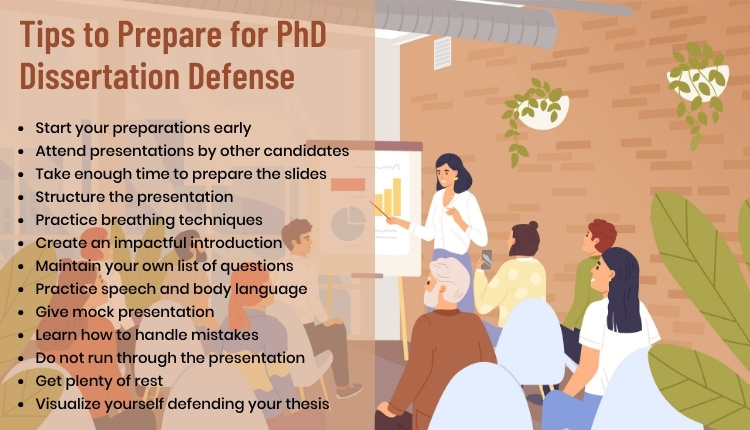
1. Start Your Preparations Early
Thesis defense is not a 3 or 6 months’ exercise. Don’t wait until you have completed all your research objectives. Start your preparation well in advance, and make sure you know all the intricacies of your thesis and reasons to all the research experiments you conducted.
2. Attend Presentations by Other Candidates
Look out for open dissertation presentations at your university. In fact, you can attend open dissertation presentations at other universities too. Firstly, this will help you realize how thesis defense is not a scary process. Secondly, you will get the tricks and hacks on how other researchers are defending their thesis. Finally, you will understand why dissertation defense is necessary for the university, as well as the scientific community.
3. Take Enough Time to Prepare the Slides
Dissertation defense process harder than submitting your thesis well before the deadline. Ideally, you could start preparing the slides after finalizing your thesis. Spend more time in preparing the slides. Make sure you got the right data on the slides and rephrase your inferences, to create a logical flow to your presentation.
4. Structure the Presentation
Do not be haphazard in designing your presentation. Take time to create a good structured presentation. Furthermore, create high-quality slides which impresses the committee members. Make slides that hold your audience’s attention. Keep the presentation thorough and accurate, and use smart art to create better slides.
5. Practice Breathing Techniques
Watch a few TED talk videos and you will notice that speakers and orators are very fluent at their speech. In fact, you will not notice them taking a breath or falling short of breath. The only reason behind such effortless oratory skill is practice — practice in breathing technique.
Moreover, every speaker knows how to control their breath. Long and steady breaths are crucial. Pay attention to your breathing and slow it down. All you need I some practice prior to this moment.
6. Create an Impactful Introduction
The audience expects a lot from you. So your opening statement should enthrall the audience. Furthermore, your thesis should create an impact on the members; they should be thrilled by your thesis and the way you expose it.
The introduction answers most important questions, and most important of all “Is this presentation worth the time?” Therefore, it is important to make a good first impression , because the first few minutes sets the tone for your entire presentation.
7. Maintain Your Own List of Questions
While preparing for the presentation, make a note of all the questions that you ask yourself. Try to approach all the questions from a reader’s point of view. You could pretend like you do not know the topic and think of questions that could help you know the topic much better.
The list of questions will prepare you for the questions the members may pose while trying to understand your research. Attending other candidates’ open discussion will also help you assume the dissertation defense questions.
8. Practice Speech and Body Language
After successfully preparing your slides and practicing, you could start focusing on how you look while presenting your thesis. This exercise is not for your appearance but to know your body language and relax if need be.
Pay attention to your body language. Stand with your back straight, but relax your shoulders. The correct posture will give you the feel of self-confidence. So, observe yourself in the mirror and pay attention to movements you make.
9. Give Mock Presentation
Giving a trial defense in advance is a good practice. The most important factor for the mock defense is its similarity to your real defense, so that you get the experience that prepares for the actual defense.
10. Learn How to Handle Mistakes
Everyone makes mistakes. However, it is important to carry on. Do not let the mistakes affect your thesis defense. Take a deep breath and move on to the next point.
11. Do Not Run Through the Presentation
If you are nervous, you would want to end the presentation as soon as possible. However, this situation will give rise to anxiety and you will speak too fast, skipping the essential details. Eventually, creating a fiasco of your dissertation defense .
12. Get Plenty of Rest
Out of the dissertation defense preparation points, this one is extremely important. Obviously, sleeping a day before your big event is hard, but you have to focus and go to bed early, with the clear intentions of getting the rest you deserve.
13. Visualize Yourself Defending Your Thesis
This simple exercise creates an immense impact on your self-confidence. All you have to do is visualize yourself giving a successful presentation each evening before going to sleep. Everyday till the day of your thesis defense, see yourself standing in front of the audience and going from one point to another.
This exercise takes a lot of commitment and persistence, but the results in the end are worth it. Visualization makes you see yourself doing the scary thing of defending your thesis.
If you have taken all these points into consideration, you are ready for your big day. You have worked relentlessly for your PhD degree , and you will definitely give your best in this final step.
Have you completed your thesis defense? How did you prepare for it and how was your experience throughout your dissertation defense ? Do write to us or comment below.
The tips are very useful.I will recomend it to our students.
Excellent. As a therapist trying to help a parent of a candidate, I am very impressed and thankful your concise, clear, action-oriented article. Thank you.
Thanks for your sharing. It is so good. I can learn a lot from your ideas. Hope that in my dissertation defense next time I can pass
The tips are effective. Will definitely apply them in my dissertation.
My dissertation defense is coming up in less than two weeks from now, I find this tips quite instructive, I’ll definitely apply them. Thank you so much.
Rate this article Cancel Reply
Your email address will not be published.

Enago Academy's Most Popular Articles

- Reporting Research
Choosing the Right Analytical Approach: Thematic analysis vs. content analysis for data interpretation
In research, choosing the right approach to understand data is crucial for deriving meaningful insights.…

Comparing Cross Sectional and Longitudinal Studies: 5 steps for choosing the right approach
The process of choosing the right research design can put ourselves at the crossroads of…

- Career Corner
Unlocking the Power of Networking in Academic Conferences
Embarking on your first academic conference experience? Fear not, we got you covered! Academic conferences…

Research Recommendations – Guiding policy-makers for evidence-based decision making
Research recommendations play a crucial role in guiding scholars and researchers toward fruitful avenues of…

- AI in Academia
Disclosing the Use of Generative AI: Best practices for authors in manuscript preparation
The rapid proliferation of generative and other AI-based tools in research writing has ignited an…
Setting Rationale in Research: Cracking the code for excelling at research
Mitigating Survivorship Bias in Scholarly Research: 10 tips to enhance data integrity
The Power of Proofreading: Taking your academic work to the next level
Facing Difficulty Writing an Academic Essay? — Here is your one-stop solution!

Sign-up to read more
Subscribe for free to get unrestricted access to all our resources on research writing and academic publishing including:
- 2000+ blog articles
- 50+ Webinars
- 10+ Expert podcasts
- 50+ Infographics
- 10+ Checklists
- Research Guides
We hate spam too. We promise to protect your privacy and never spam you.
I am looking for Editing/ Proofreading services for my manuscript Tentative date of next journal submission:

As a researcher, what do you consider most when choosing an image manipulation detector?
Purdue Online Writing Lab Purdue OWL® College of Liberal Arts
Welcome to the Purdue Online Writing Lab

Welcome to the Purdue OWL
This page is brought to you by the OWL at Purdue University. When printing this page, you must include the entire legal notice.
Copyright ©1995-2018 by The Writing Lab & The OWL at Purdue and Purdue University. All rights reserved. This material may not be published, reproduced, broadcast, rewritten, or redistributed without permission. Use of this site constitutes acceptance of our terms and conditions of fair use.
The Online Writing Lab at Purdue University houses writing resources and instructional material, and we provide these as a free service of the Writing Lab at Purdue. Students, members of the community, and users worldwide will find information to assist with many writing projects. Teachers and trainers may use this material for in-class and out-of-class instruction.
The Purdue On-Campus Writing Lab and Purdue Online Writing Lab assist clients in their development as writers—no matter what their skill level—with on-campus consultations, online participation, and community engagement. The Purdue Writing Lab serves the Purdue, West Lafayette, campus and coordinates with local literacy initiatives. The Purdue OWL offers global support through online reference materials and services.
A Message From the Assistant Director of Content Development
The Purdue OWL® is committed to supporting students, instructors, and writers by offering a wide range of resources that are developed and revised with them in mind. To do this, the OWL team is always exploring possibilties for a better design, allowing accessibility and user experience to guide our process. As the OWL undergoes some changes, we welcome your feedback and suggestions by email at any time.
Please don't hesitate to contact us via our contact page if you have any questions or comments.
All the best,
Social Media
Facebook twitter.
Have a language expert improve your writing
Run a free plagiarism check in 10 minutes, generate accurate citations for free.
- Knowledge Base
Methodology
- How to Write a Literature Review | Guide, Examples, & Templates
How to Write a Literature Review | Guide, Examples, & Templates
Published on January 2, 2023 by Shona McCombes . Revised on September 11, 2023.
What is a literature review? A literature review is a survey of scholarly sources on a specific topic. It provides an overview of current knowledge, allowing you to identify relevant theories, methods, and gaps in the existing research that you can later apply to your paper, thesis, or dissertation topic .
There are five key steps to writing a literature review:
- Search for relevant literature
- Evaluate sources
- Identify themes, debates, and gaps
- Outline the structure
- Write your literature review
A good literature review doesn’t just summarize sources—it analyzes, synthesizes , and critically evaluates to give a clear picture of the state of knowledge on the subject.
Instantly correct all language mistakes in your text
Upload your document to correct all your mistakes in minutes

Table of contents
What is the purpose of a literature review, examples of literature reviews, step 1 – search for relevant literature, step 2 – evaluate and select sources, step 3 – identify themes, debates, and gaps, step 4 – outline your literature review’s structure, step 5 – write your literature review, free lecture slides, other interesting articles, frequently asked questions, introduction.
- Quick Run-through
- Step 1 & 2
When you write a thesis , dissertation , or research paper , you will likely have to conduct a literature review to situate your research within existing knowledge. The literature review gives you a chance to:
- Demonstrate your familiarity with the topic and its scholarly context
- Develop a theoretical framework and methodology for your research
- Position your work in relation to other researchers and theorists
- Show how your research addresses a gap or contributes to a debate
- Evaluate the current state of research and demonstrate your knowledge of the scholarly debates around your topic.
Writing literature reviews is a particularly important skill if you want to apply for graduate school or pursue a career in research. We’ve written a step-by-step guide that you can follow below.

Prevent plagiarism. Run a free check.
Writing literature reviews can be quite challenging! A good starting point could be to look at some examples, depending on what kind of literature review you’d like to write.
- Example literature review #1: “Why Do People Migrate? A Review of the Theoretical Literature” ( Theoretical literature review about the development of economic migration theory from the 1950s to today.)
- Example literature review #2: “Literature review as a research methodology: An overview and guidelines” ( Methodological literature review about interdisciplinary knowledge acquisition and production.)
- Example literature review #3: “The Use of Technology in English Language Learning: A Literature Review” ( Thematic literature review about the effects of technology on language acquisition.)
- Example literature review #4: “Learners’ Listening Comprehension Difficulties in English Language Learning: A Literature Review” ( Chronological literature review about how the concept of listening skills has changed over time.)
You can also check out our templates with literature review examples and sample outlines at the links below.
Download Word doc Download Google doc
Before you begin searching for literature, you need a clearly defined topic .
If you are writing the literature review section of a dissertation or research paper, you will search for literature related to your research problem and questions .
Make a list of keywords
Start by creating a list of keywords related to your research question. Include each of the key concepts or variables you’re interested in, and list any synonyms and related terms. You can add to this list as you discover new keywords in the process of your literature search.
- Social media, Facebook, Instagram, Twitter, Snapchat, TikTok
- Body image, self-perception, self-esteem, mental health
- Generation Z, teenagers, adolescents, youth
Search for relevant sources
Use your keywords to begin searching for sources. Some useful databases to search for journals and articles include:
- Your university’s library catalogue
- Google Scholar
- Project Muse (humanities and social sciences)
- Medline (life sciences and biomedicine)
- EconLit (economics)
- Inspec (physics, engineering and computer science)
You can also use boolean operators to help narrow down your search.
Make sure to read the abstract to find out whether an article is relevant to your question. When you find a useful book or article, you can check the bibliography to find other relevant sources.
You likely won’t be able to read absolutely everything that has been written on your topic, so it will be necessary to evaluate which sources are most relevant to your research question.
For each publication, ask yourself:
- What question or problem is the author addressing?
- What are the key concepts and how are they defined?
- What are the key theories, models, and methods?
- Does the research use established frameworks or take an innovative approach?
- What are the results and conclusions of the study?
- How does the publication relate to other literature in the field? Does it confirm, add to, or challenge established knowledge?
- What are the strengths and weaknesses of the research?
Make sure the sources you use are credible , and make sure you read any landmark studies and major theories in your field of research.
You can use our template to summarize and evaluate sources you’re thinking about using. Click on either button below to download.
Take notes and cite your sources
As you read, you should also begin the writing process. Take notes that you can later incorporate into the text of your literature review.
It is important to keep track of your sources with citations to avoid plagiarism . It can be helpful to make an annotated bibliography , where you compile full citation information and write a paragraph of summary and analysis for each source. This helps you remember what you read and saves time later in the process.
Don't submit your assignments before you do this
The academic proofreading tool has been trained on 1000s of academic texts. Making it the most accurate and reliable proofreading tool for students. Free citation check included.

Try for free
To begin organizing your literature review’s argument and structure, be sure you understand the connections and relationships between the sources you’ve read. Based on your reading and notes, you can look for:
- Trends and patterns (in theory, method or results): do certain approaches become more or less popular over time?
- Themes: what questions or concepts recur across the literature?
- Debates, conflicts and contradictions: where do sources disagree?
- Pivotal publications: are there any influential theories or studies that changed the direction of the field?
- Gaps: what is missing from the literature? Are there weaknesses that need to be addressed?
This step will help you work out the structure of your literature review and (if applicable) show how your own research will contribute to existing knowledge.
- Most research has focused on young women.
- There is an increasing interest in the visual aspects of social media.
- But there is still a lack of robust research on highly visual platforms like Instagram and Snapchat—this is a gap that you could address in your own research.
There are various approaches to organizing the body of a literature review. Depending on the length of your literature review, you can combine several of these strategies (for example, your overall structure might be thematic, but each theme is discussed chronologically).
Chronological
The simplest approach is to trace the development of the topic over time. However, if you choose this strategy, be careful to avoid simply listing and summarizing sources in order.
Try to analyze patterns, turning points and key debates that have shaped the direction of the field. Give your interpretation of how and why certain developments occurred.
If you have found some recurring central themes, you can organize your literature review into subsections that address different aspects of the topic.
For example, if you are reviewing literature about inequalities in migrant health outcomes, key themes might include healthcare policy, language barriers, cultural attitudes, legal status, and economic access.
Methodological
If you draw your sources from different disciplines or fields that use a variety of research methods , you might want to compare the results and conclusions that emerge from different approaches. For example:
- Look at what results have emerged in qualitative versus quantitative research
- Discuss how the topic has been approached by empirical versus theoretical scholarship
- Divide the literature into sociological, historical, and cultural sources
Theoretical
A literature review is often the foundation for a theoretical framework . You can use it to discuss various theories, models, and definitions of key concepts.
You might argue for the relevance of a specific theoretical approach, or combine various theoretical concepts to create a framework for your research.
Like any other academic text , your literature review should have an introduction , a main body, and a conclusion . What you include in each depends on the objective of your literature review.
The introduction should clearly establish the focus and purpose of the literature review.
Depending on the length of your literature review, you might want to divide the body into subsections. You can use a subheading for each theme, time period, or methodological approach.
As you write, you can follow these tips:
- Summarize and synthesize: give an overview of the main points of each source and combine them into a coherent whole
- Analyze and interpret: don’t just paraphrase other researchers — add your own interpretations where possible, discussing the significance of findings in relation to the literature as a whole
- Critically evaluate: mention the strengths and weaknesses of your sources
- Write in well-structured paragraphs: use transition words and topic sentences to draw connections, comparisons and contrasts
In the conclusion, you should summarize the key findings you have taken from the literature and emphasize their significance.
When you’ve finished writing and revising your literature review, don’t forget to proofread thoroughly before submitting. Not a language expert? Check out Scribbr’s professional proofreading services !
This article has been adapted into lecture slides that you can use to teach your students about writing a literature review.
Scribbr slides are free to use, customize, and distribute for educational purposes.
Open Google Slides Download PowerPoint
If you want to know more about the research process , methodology , research bias , or statistics , make sure to check out some of our other articles with explanations and examples.
- Sampling methods
- Simple random sampling
- Stratified sampling
- Cluster sampling
- Likert scales
- Reproducibility
Statistics
- Null hypothesis
- Statistical power
- Probability distribution
- Effect size
- Poisson distribution
Research bias
- Optimism bias
- Cognitive bias
- Implicit bias
- Hawthorne effect
- Anchoring bias
- Explicit bias
A literature review is a survey of scholarly sources (such as books, journal articles, and theses) related to a specific topic or research question .
It is often written as part of a thesis, dissertation , or research paper , in order to situate your work in relation to existing knowledge.
There are several reasons to conduct a literature review at the beginning of a research project:
- To familiarize yourself with the current state of knowledge on your topic
- To ensure that you’re not just repeating what others have already done
- To identify gaps in knowledge and unresolved problems that your research can address
- To develop your theoretical framework and methodology
- To provide an overview of the key findings and debates on the topic
Writing the literature review shows your reader how your work relates to existing research and what new insights it will contribute.
The literature review usually comes near the beginning of your thesis or dissertation . After the introduction , it grounds your research in a scholarly field and leads directly to your theoretical framework or methodology .
A literature review is a survey of credible sources on a topic, often used in dissertations , theses, and research papers . Literature reviews give an overview of knowledge on a subject, helping you identify relevant theories and methods, as well as gaps in existing research. Literature reviews are set up similarly to other academic texts , with an introduction , a main body, and a conclusion .
An annotated bibliography is a list of source references that has a short description (called an annotation ) for each of the sources. It is often assigned as part of the research process for a paper .
Cite this Scribbr article
If you want to cite this source, you can copy and paste the citation or click the “Cite this Scribbr article” button to automatically add the citation to our free Citation Generator.
McCombes, S. (2023, September 11). How to Write a Literature Review | Guide, Examples, & Templates. Scribbr. Retrieved June 7, 2024, from https://www.scribbr.com/dissertation/literature-review/
Is this article helpful?
Shona McCombes
Other students also liked, what is a theoretical framework | guide to organizing, what is a research methodology | steps & tips, how to write a research proposal | examples & templates, what is your plagiarism score.
👀 Turn any prompt into captivating visuals in seconds with our AI-powered design generator ✨ Try Piktochart AI!
- Piktochart Visual
- Video Editor
- AI Design Generator
- Infographic Maker
- Banner Maker
- Brochure Maker
- Diagram Maker
- Flowchart Maker
- Flyer Maker
- Graph Maker
- Invitation Maker
- Pitch Deck Creator
- Poster Maker
- Presentation Maker
- Report Maker
- Resume Maker
- Social Media Graphic Maker
- Timeline Maker
- Venn Diagram Maker
- Screen Recorder
- Social Media Video Maker
- Video Cropper
- Video to Text Converter
- Video Views Calculator
- AI Brochure Maker
- AI Document Generator
- AI Flyer Generator
- AI Image Generator
- AI Infographic
- AI Instagram Post Generator
- AI Newsletter Generator
- AI Quote Generator
- AI Report Generator
- AI Timeline Generator
- For Communications
- For Education
- For eLearning
- For Financial Services
- For Healthcare
- For Human Resources
- For Marketing
- For Nonprofits
- Brochure Templates
- Flyer Templates
- Infographic Templates
- Newsletter Templates
- Presentation Templates
- Resume Templates
- Business Infographics
- Business Proposals
- Education Templates
- Health Posters
- HR Templates
- Sales Presentations
- Community Template
- Explore all free templates on Piktochart
- Course: What is Visual Storytelling?
- The Business Storyteller Podcast
- User Stories
- Video Tutorials
- Need help? Check out our Help Center
- Earn money as a Piktochart Affiliate Partner
- Compare prices and features across Free, Pro, and Enterprise plans.
- For professionals and small teams looking for better brand management.
- For organizations seeking enterprise-grade onboarding, support, and SSO.
- Discounted plan for students, teachers, and education staff.
- Great causes deserve great pricing. Registered nonprofits pay less.
AI-Powered Poster Generator
With the Piktochart AI poster generator, you can turn any prompt into a gorgeous poster in seconds. No design skills? No problem. Just tweak it as you wish, then share your poster.
The new way of creating posters
Create in a Flash
Prompt to poster in 10 seconds
Say goodbye to complicated design steps. Simply type in your theme and watch as our AI poster maker transforms it into reality.
AI Image Generation
Bring your vision to life
Go stock photos and generate images that are contextualized to your needs with our advanced AI image generator. Put your creativity to the test and generate highly realistic images that make you stand out.
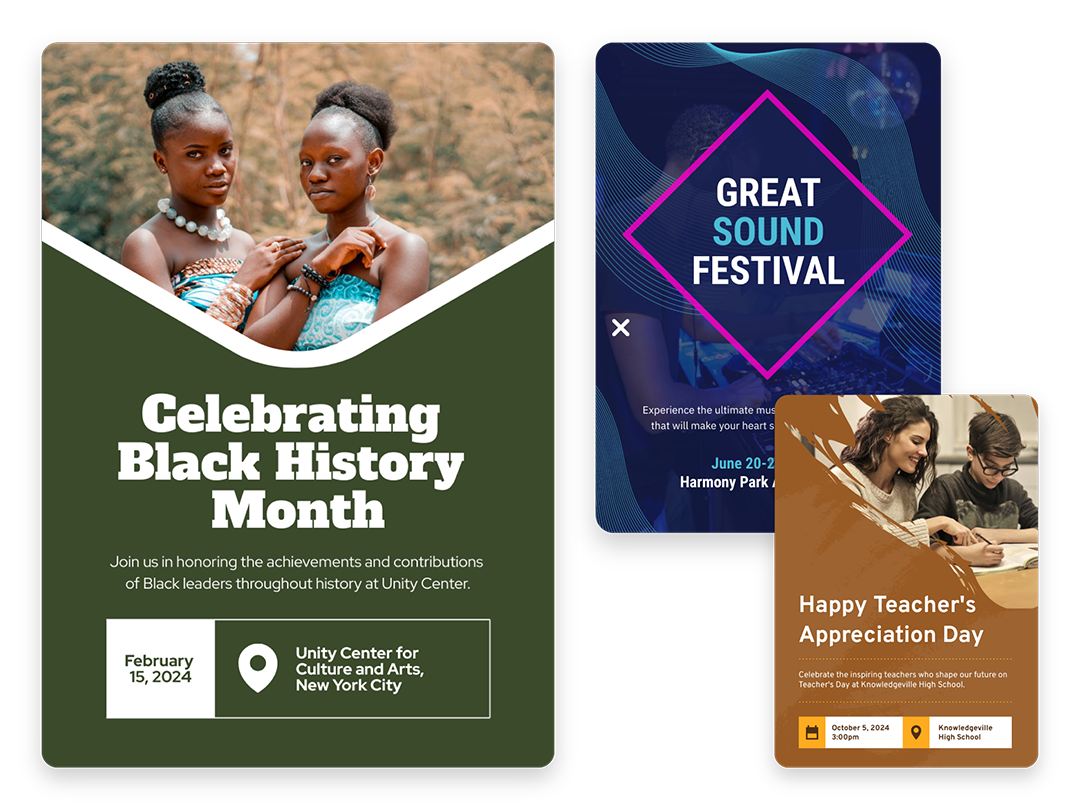
Create Without Limits
Where every idea finds its canvas
For events, marketing, learning, or personal creations, Piktochart AI delivers captivating poster designs for every need. Dive into a universe of impressive imagery tailored to suit any subject.

Create Your Vision
Piktochart starts, you put the finishing touches
Our AI sets the stage with a professionally crafted poster, then passes control to you, allowing you to modify and refine each detail to amplify your visual impact while keeping true to your brand.
Posters created using Piktochart’s AI-powered poster maker

Professionals like you use Piktochart’s free online poster maker to:

- Create eye-catching promotional materials that align with brand identity, ideal for advertising campaigns, product launches, and trade shows.
- Design captivating posters for corporate events, webinars, and conferences.
- Communicate new offers, services, or store openings.

HR & Internal Comms
- Internal announcements, motivational quotes, or event notifications.
- Job advertisements and onboarding materials to attract and welcome new employees.
- Convey important company policies and reminders through clear, engaging posters, ensuring better compliance and awareness.

NGOs and Government Organizations
- Develop impactful posters for awareness drives, fundraising events, and community outreach programs.
- Attract volunteers, highlighting the roles, benefits, and the difference they can make.
- Announce charity events, workshops, and seminars.

- Create informative posters on health topics, wellness tips, and medical advisories.
- Showcase healthcare services, specialist departments, and new medical technologies available at healthcare facilities.
- Display important health and safety protocols within healthcare settings.
How to Make a Digital Poster
1. Define Your Story
Briefly describe (within 120 characters) the purpose behind your poster. Whether it’s for promotion, making an announcement, driving awareness, or sharing health information.
2. Select from Our Varied Poster Designs
Jumpstart your project with our array of ready-to-use poster templates, perfect for shining a spotlight on any subject. After picking your preferred design, you’ll find yourself in our editing suite.
3. Tweak the Design with Piktochart Editor
With your template chosen, hitting the “Edit” button grants you entry into the Piktochart editor. This is your playground to adjust, alter, and align the design to reflect your personal touch and message.
4. Enhance with Visual Elements
Piktochart’s user-friendly drag-and-drop editor makes personalization a breeze. Tap into our rich collection of complimentary photos, icons, illustrations, and text options to craft a poster that stands out. Enhancing and tailoring colors is just a click away with our versatile design tool.
5. Publish and Promote
Once your poster is exactly as you envisioned, it’s time to save and share your work. Export in various formats like JPG, PNG, or PDF, catering to both digital platforms and print materials.
AI-Powered Visualization for Any Topic
What kinds of posters can be generated using this AI tool?
Navigating design elements and finding the right visual style can be daunting. With Piktochart AI, it’s easy to transform data into high-quality posters . Excellence made simple, just for you.
Event posters
Drum up buzz and awareness for an upcoming event. Piktochart AI transform dense data and information into engaging invitational posters for your events.
Advertising posters
Spark emotions that incite action – whether it is to make a purchase, improve brand opinion, donate to a cause, or make a lifestyle change. With Piktochart AI, it’s achievable at the click of a button.
Conference posters
Inform your audience with a glance about an upcoming conference. Whether it’s for a medical conference, marketing conference, or any conferences, Piktochart AI’s user-friendly poster maker helps you catch the attention of your audience effortlessly.
Ready to use AI to design posters like a pro?
Join more than 11 million people who already use Piktochart to create stunning posters.
Is it possible to personalize my poster with my own photos and diagrams?
What’s the limit on poster creation, how do i enhance the quality of my posters, is signing up mandatory to use piktochart, poster resources.

How to Make a Poster in 6 Easy Steps [2023 Guide With Templates]

25 Poster Ideas, Templates, and Tips for Creative Inspiration

Communications
7 Types of Posters and What Makes Them Stand Out
What else can you create with piktochart ai.
Got any suggestions?
We want to hear from you! Send us a message and help improve Slidesgo
Top searches
Trending searches

indigenous canada
8 templates

6 templates

ancient china
29 templates

welcome back to school
124 templates
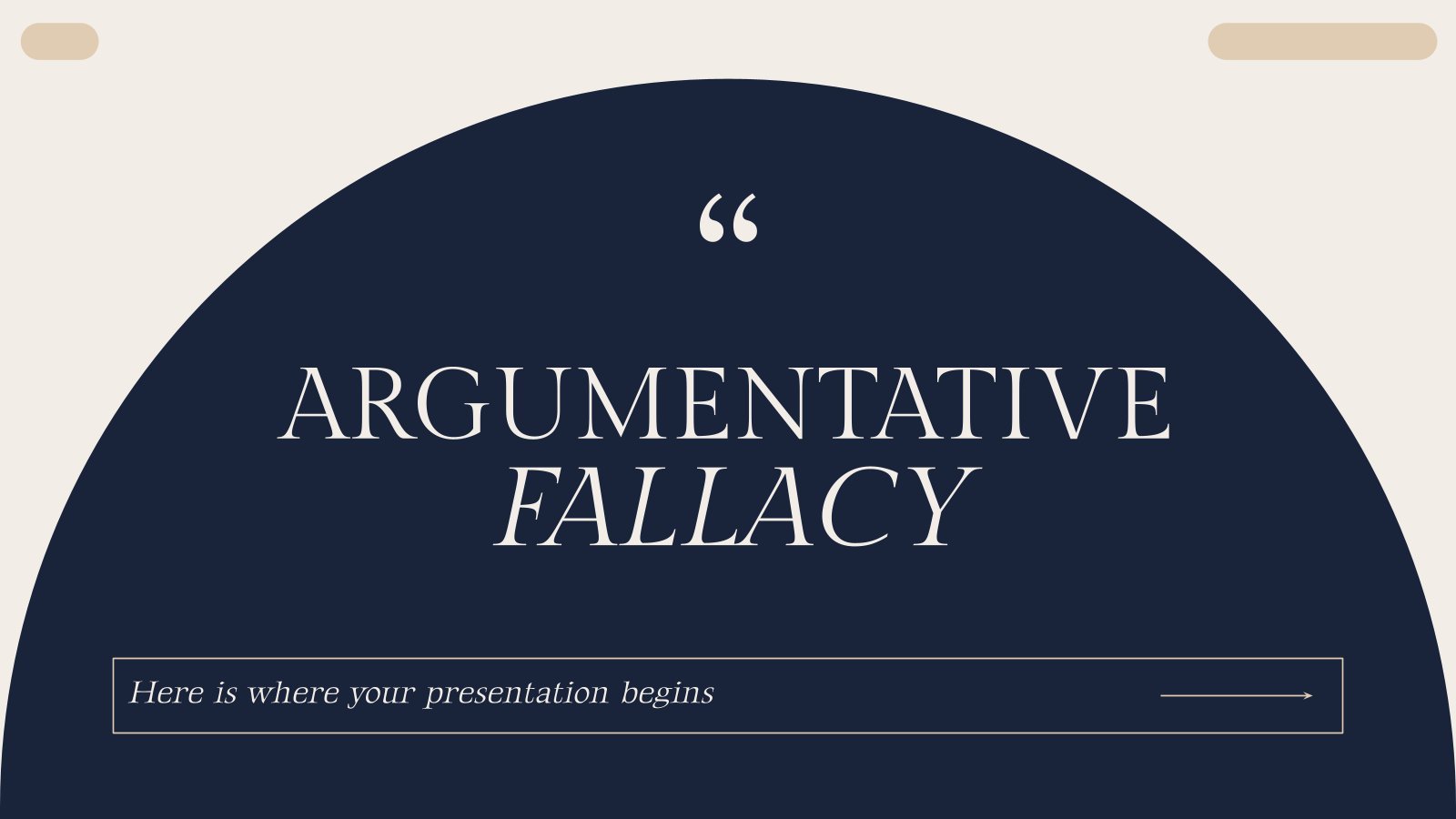
113 templates

first day of school
68 templates
Animal Welfare in the Swine Industry Thesis Defense
It seems that you like this template, animal welfare in the swine industry thesis defense presentation, free google slides theme and powerpoint template.
Download the Animal Welfare in the Swine Industry Thesis Defense presentation for PowerPoint or Google Slides. Congratulations, you have finally finished your research and made it to the end of your thesis! But now comes the big moment: the thesis defense. You want to make sure you showcase your research in the best way possible and impress your advisors. That's where this amazing template comes in. With it, you can be sure that your presentation will be top-notch and you'll be well on your way to success. Create a perfect presentation for your next thesis defense by using this template now!
Features of this template
- 100% editable and easy to modify
- Different slides to impress your audience
- Contains easy-to-edit graphics such as graphs, maps, tables, timelines and mockups
- Includes 500+ icons and Flaticon’s extension for customizing your slides
- Designed to be used in Google Slides and Microsoft PowerPoint
- Includes information about fonts, colors, and credits of the resources used
How can I use the template?
Am I free to use the templates?
How to attribute?
Attribution required If you are a free user, you must attribute Slidesgo by keeping the slide where the credits appear. How to attribute?
Related posts on our blog.

How to Add, Duplicate, Move, Delete or Hide Slides in Google Slides

How to Change Layouts in PowerPoint

How to Change the Slide Size in Google Slides
Related presentations.

Premium template
Unlock this template and gain unlimited access

Register for free and start editing online

IMAGES
VIDEO
COMMENTS
12 Free presentation templates for a Thesis Defense; Define your signature idea. Your thesis has a focus. A goal. A core concept. And this should be incorporated into your thesis defense presentation's design in every respect. A strong design will help to engage the committee and reinforce your expert understanding of your research area.
The best way to prepare for your Dissertation Presentation is to review your work carefully. Take notes of the key decisions you have made throughout your research and the scholarly literature that supports these choices. Make sure that you have a thorough understanding of the scholarly context of your research, which should have been achieved ...
Consider this information as the starting point for this chat.". Step 2: Ask for an outline. With the previously provided information, ask ChatGPT to generate an outline for your presentation. If some of the points listed in the output don't convince you, then chat with the interface until you reach a final outline.
Purpose of the Guide. This Guide was created to help Ph.D. students in engineering fields to design dissertation defense presentations. The Guide provides 1) tips on how to effectively communicate research, and 2) full presentation examples from Ph.D. graduates. The tips on designing effective slides are not restricted to dissertation defense ...
A dissertation presentation is usually a 10-15 minute overview of your dissertation research that focuses on the study and findings recorded in chapters four and five of your dissertation. The dissertation presentation consists of 9-12 slides made using PowerPoint or another type of presentation software. There are conventions to adhere to when ...
Use an appropriate language register (avoid informal language), but be approachable and natural. "Welcome to the thesis defense on [the title of your thesis]". Next, introduce yourself with your name and give a short description of your background and occupation. Don't forget to say "thank you for attending!".
Define your presentation's theme. 4. Design simple and focused slides. 5. Include data visualizations. 6. Practice makes perfect. Things to keep in mind to help you nail your presentation. You've reached the home stretch in your journey toward your post-graduate degree.
Make your thesis defense a two-way conversation by interacting with your audience. Whether it's through questions, feedback, or direct participation, engagement is key. Prezi allows for a flexible presentation style, letting you navigate sections in response to audience input, creating a dynamic and engaging experience.
2. Know Your Audience. Most people give their thesis defense presentation to an academic panel. This panel will look to see if you've developed a thorough understanding of your topic and thesis. They'll also be looking to see if you've got a solid foundation for your argument.
Are you a graduate student preparing for your thesis defense? Your thesis defense is a crucial moment in your academic career, and it's essential to be well-...
Presentations with strong narrative arcs are clear, captivating, and compelling. Orient the audience and draw them in by demonstrating the relevance and importance of your research story with strong global motive. Provide them with the necessary vocabulary and background knowledge to understand the plot of your story.
To create an engaging dissertation presentation, focus on your audience's needs and expectations. Break down complex concepts into understandable terms and provide clear explanations. Use visuals ...
Related Articles. This guide provides a 4-step process for making a good scientific presentation: outlining the scientific narrative, preparing slide outlines, constructing slides, and practicing the talk. We give advice on how to make effective slides, including tips for text, graphics, and equations, and how to use rehearsals of your talk to ...
Your PhD defense presentation is a critical step in your academic journey - one that requires a smart and sophisticated format, layout, and story flow. That's why our template includes everything you need to create an effective presentation. Tailoring this defense template to your unique PhD thesis is simple.
Provide the main argument of why the solution to the problem that you propose is important. Research Question (s)/Hypothesis (es) (1 slide): Provide the research question (s) or hypothesis (es) relevant to your field of study, written exactly as it is in your dissertation proposal. The Literature Review (2 slides):
One of the most important steps in the dissertation preparation is to understand how much time each department allocates to the closing oral defense. When you plan in the early stages of your dissertation itself, you can write it in a manner that allows you to defend it in the allocated time. Usually these meetings including the presentation ...
Preparing Your PowerPoint. Topic 3: Preparing for Defense. In this activity, you will draft your PowerPoint for your proposal defense. During your defense you will typically have 10-15 minutes for your presentation. There are approximately 9-12 slides. They have read the study, so focus more on findings and implications, less on literature.
Posters and presentations. On some courses, you may be asked to create a poster or presentation to present part of your dissertation or project. Use the resources below to help you put together a high-quality poster, and present in a confident and professional way. Always check your Brightspace module, and assignment brief, for any specific ...
For engineering, a plain, white background is generally ideal for dissertation proposals and defenses. Don't pick a template that is too busy and distracting. ... During your presentation, the committee members can use page numbers to reference specific slides for their questions. Less is more Don't put too many words on one slide (no more than ...
Here are some simple tips for creating an effective PowerPoint Presentation. Less is more: You want to give enough information to make your audience want to read your paper. So include details, but not too many, and avoid too many formulas and technical jargon. Clean and professional: Avoid excessive colors, distracting backgrounds, font ...
A dissertation is a long-form piece of academic writing based on original research conducted by you. It is usually submitted as the final step in order to finish a PhD program. Your dissertation is probably the longest piece of writing you've ever completed. It requires solid research, writing, and analysis skills, and it can be intimidating ...
When starting your thesis or dissertation process, one of the first requirements is a research proposal or a prospectus. It describes what or who you want to examine, delving into why, when, where, and how you will do so, stemming from your research question and a relevant topic. The proposal or prospectus stage is crucial for the development ...
Microsoft Word - Dissertation Defense guidlines (1).docx. Preparing a Presentation for Your Dissertation Defense: Guidelines. Build the Presentation: Use the presentation from your proposal defense as a start Edit down your proposal presentation } Summarize Chapters 1-‐3 Focus on Chapters 4-‐5.
Dissertation defense process harder than submitting your thesis well before the deadline. Ideally, you could start preparing the slides after finalizing your thesis. Spend more time in preparing the slides. Make sure you got the right data on the slides and rephrase your inferences, to create a logical flow to your presentation. 4.
Mission. The Purdue On-Campus Writing Lab and Purdue Online Writing Lab assist clients in their development as writers—no matter what their skill level—with on-campus consultations, online participation, and community engagement. The Purdue Writing Lab serves the Purdue, West Lafayette, campus and coordinates with local literacy initiatives.
Examples of literature reviews. Step 1 - Search for relevant literature. Step 2 - Evaluate and select sources. Step 3 - Identify themes, debates, and gaps. Step 4 - Outline your literature review's structure. Step 5 - Write your literature review.
4. Enhance with Visual Elements. Piktochart's user-friendly drag-and-drop editor makes personalization a breeze. Tap into our rich collection of complimentary photos, icons, illustrations, and text options to craft a poster that stands out. Enhancing and tailoring colors is just a click away with our versatile design tool. 5.
An abstract is a 150- to 250-word paragraph that provides readers with a quick overview of your essay or report and its organization. It should express your thesis (or central idea) and your key points; it should also suggest any implications or applications of the research you discuss in the paper. According to Carole Slade, an abstract is ...
Download the Animal Welfare in the Swine Industry Thesis Defense presentation for PowerPoint or Google Slides. Congratulations, you have finally finished your research and made it to the end of your thesis! But now comes the big moment: the thesis defense. You want to make sure you showcase your research in the best way possible and impress ...